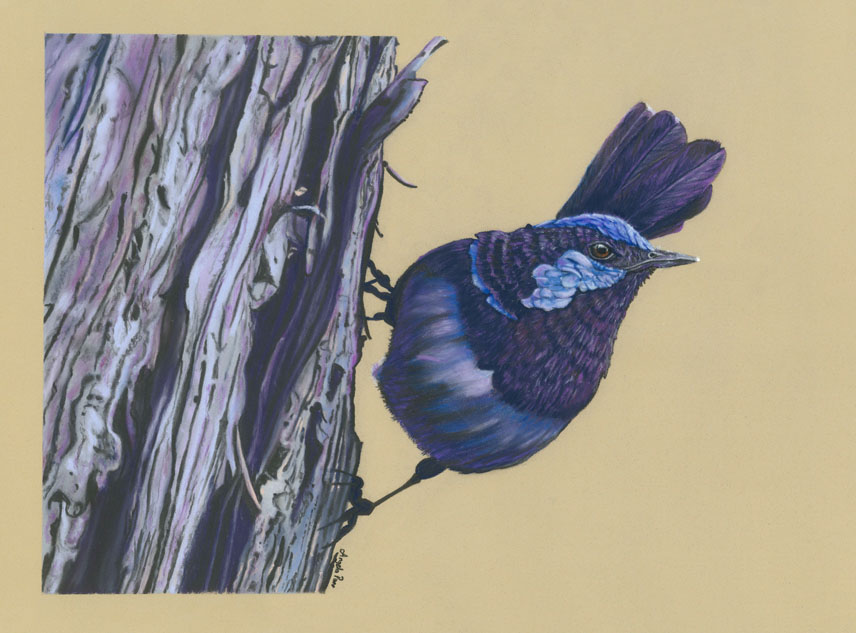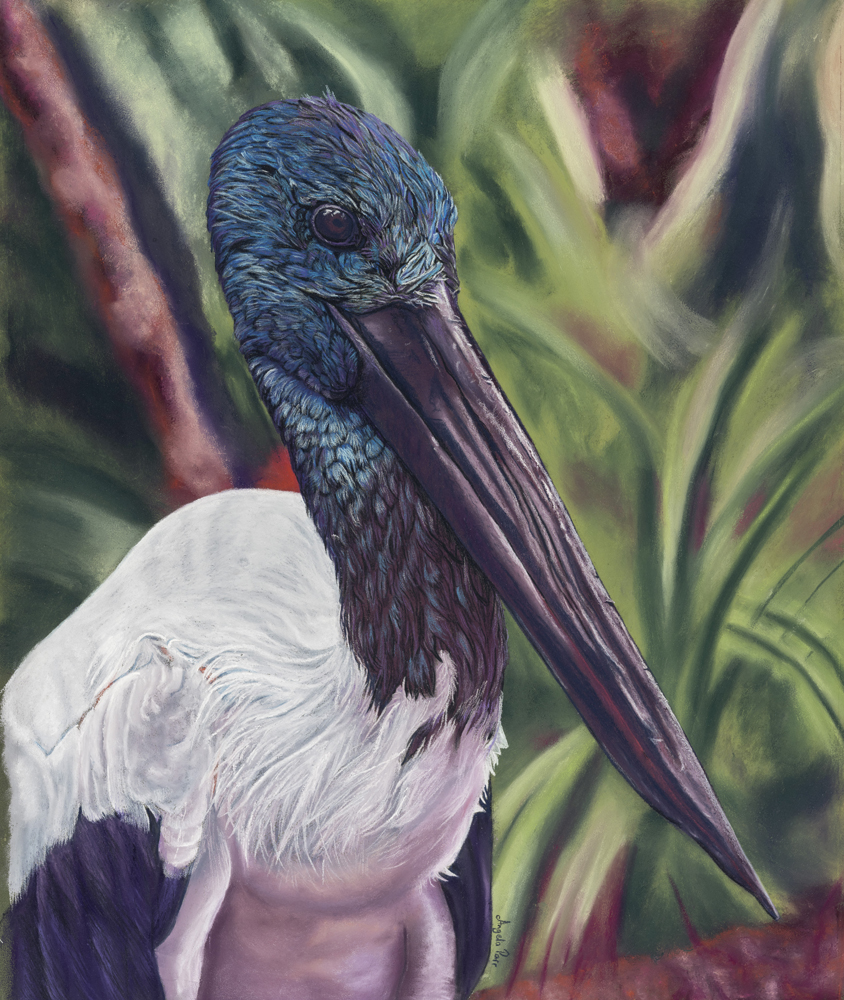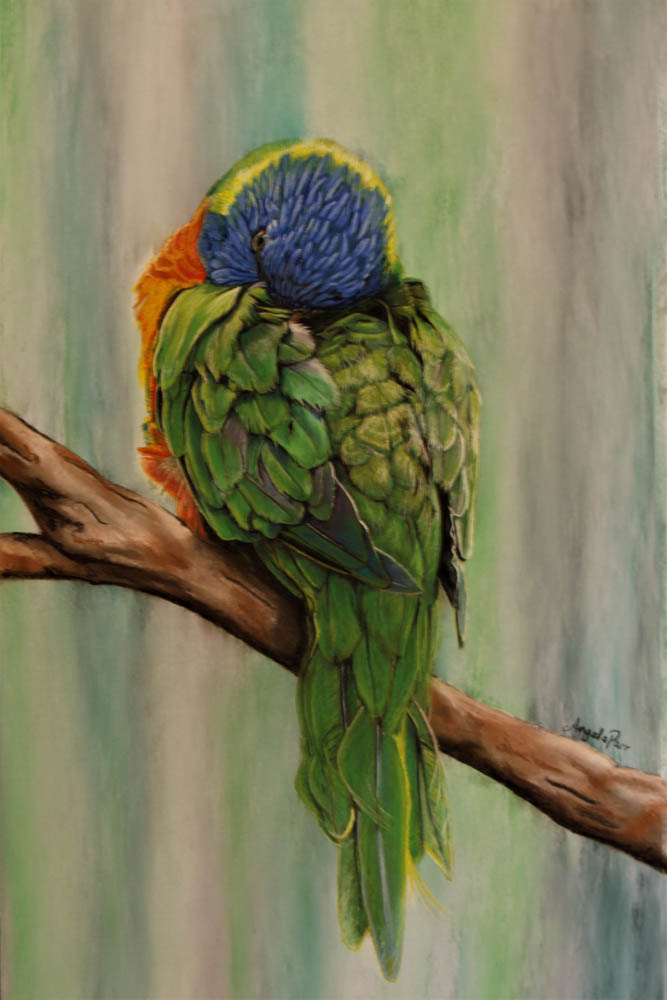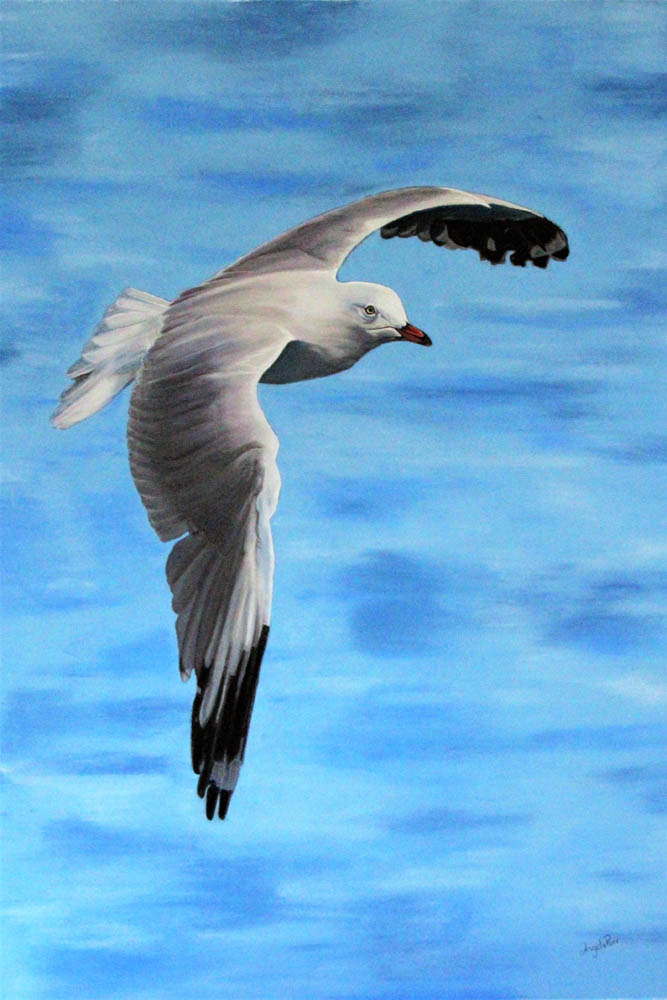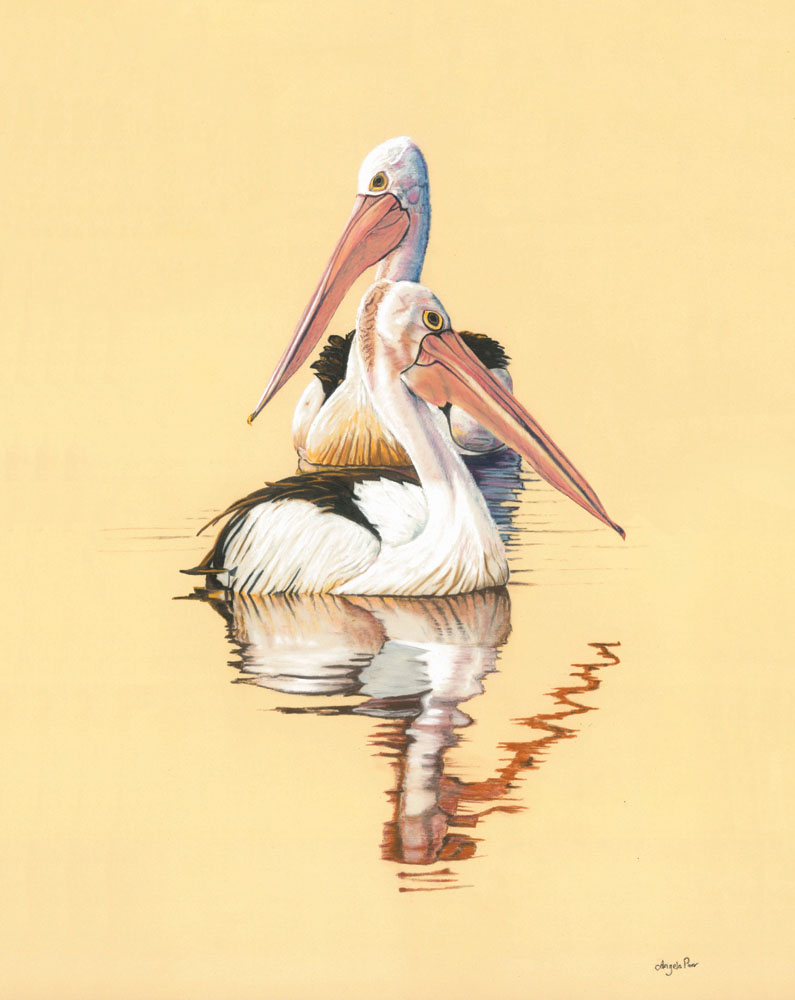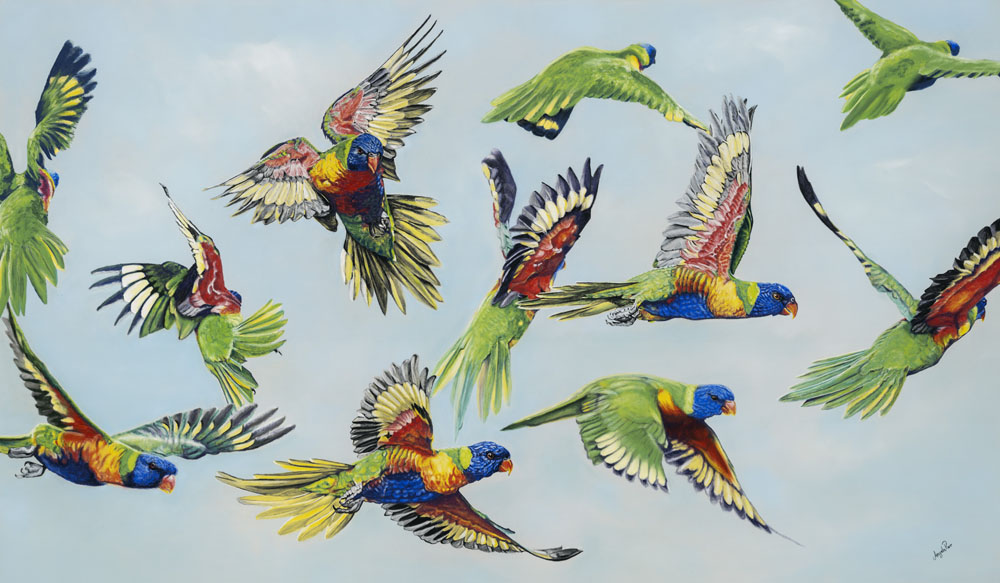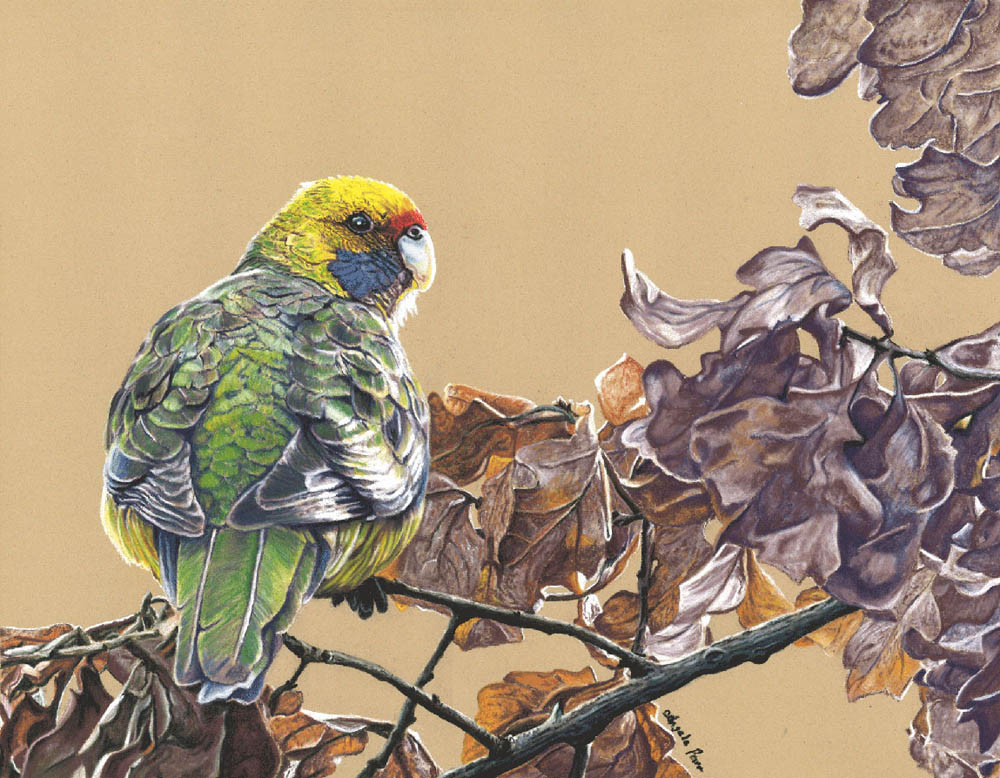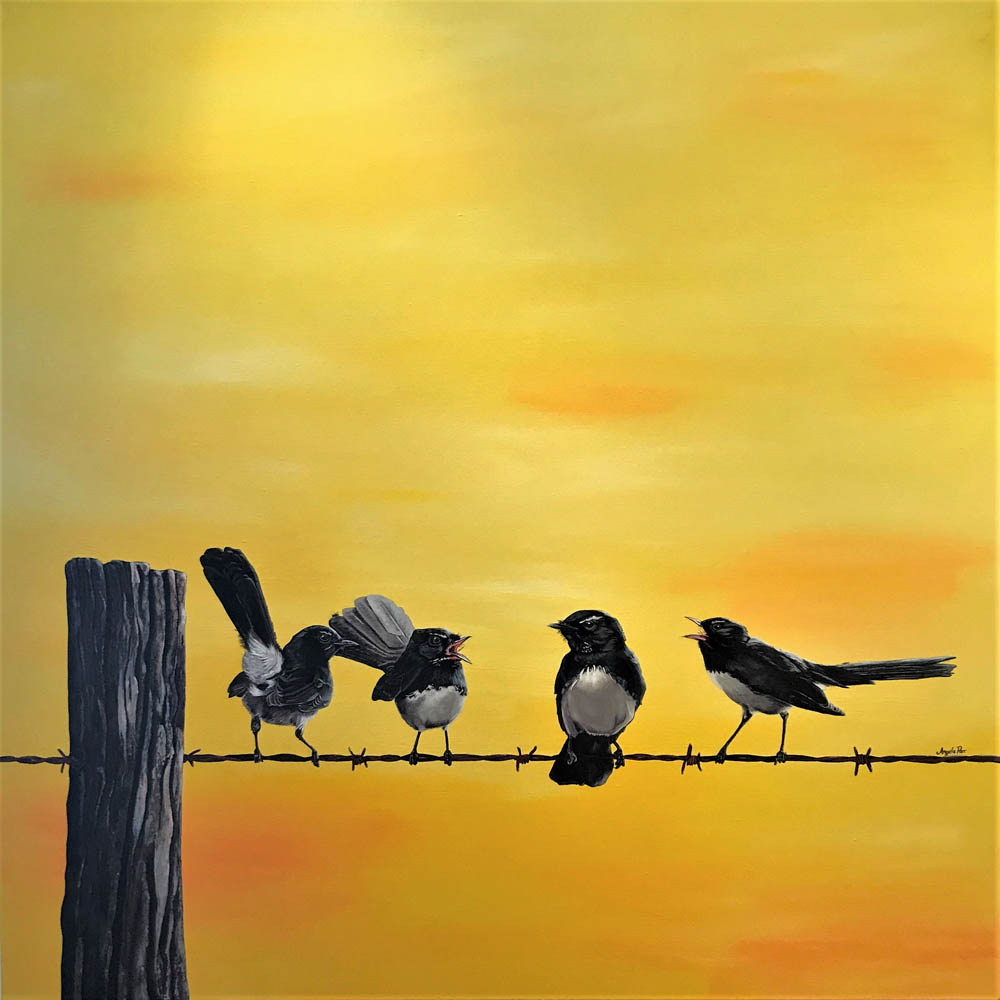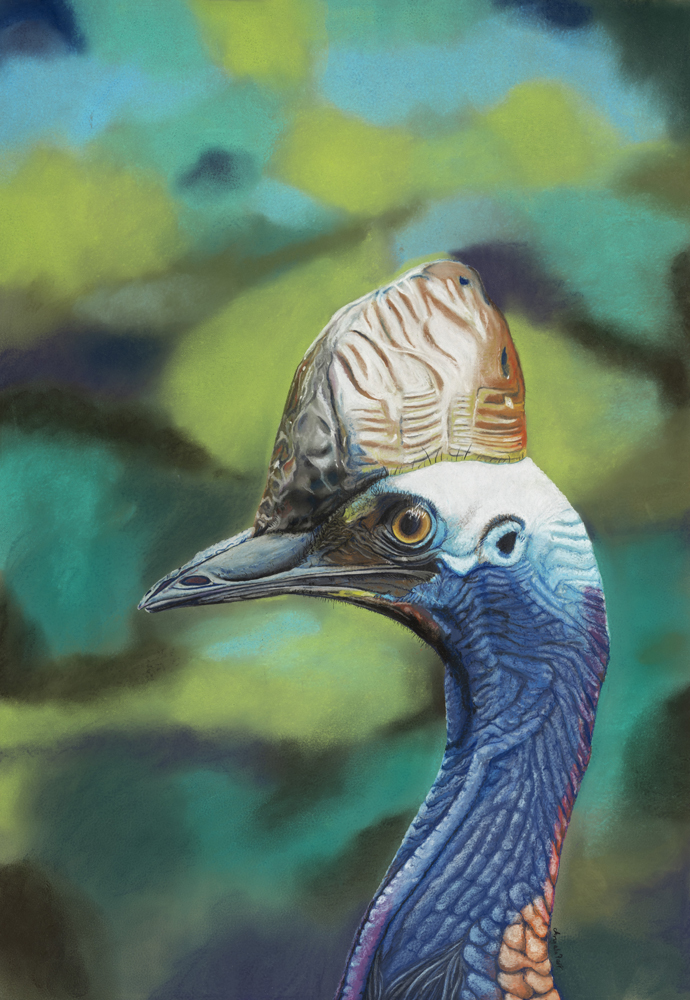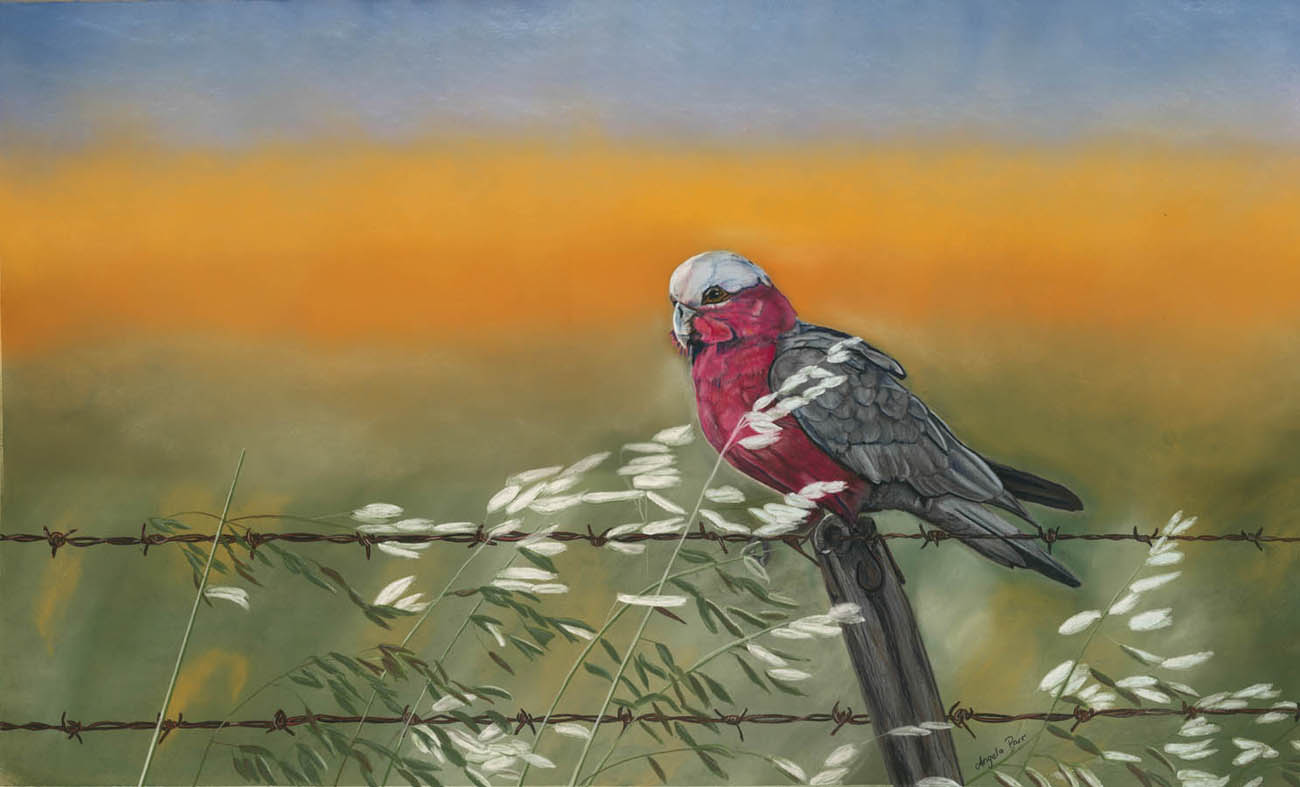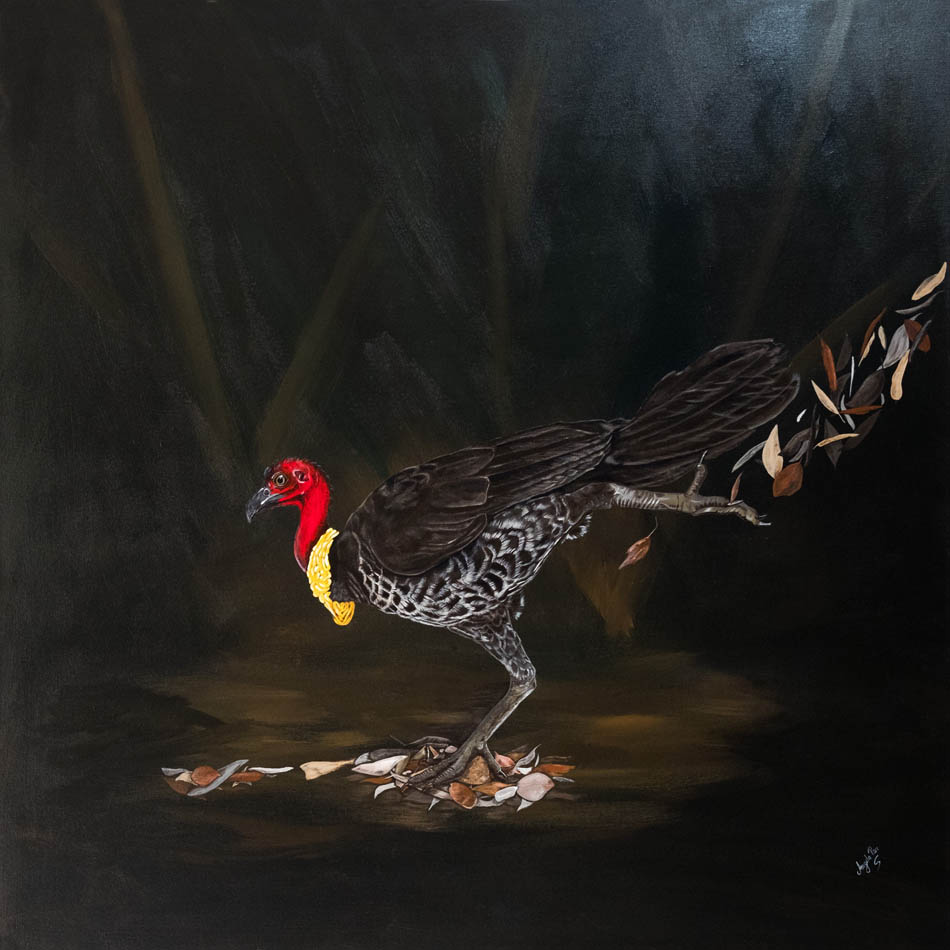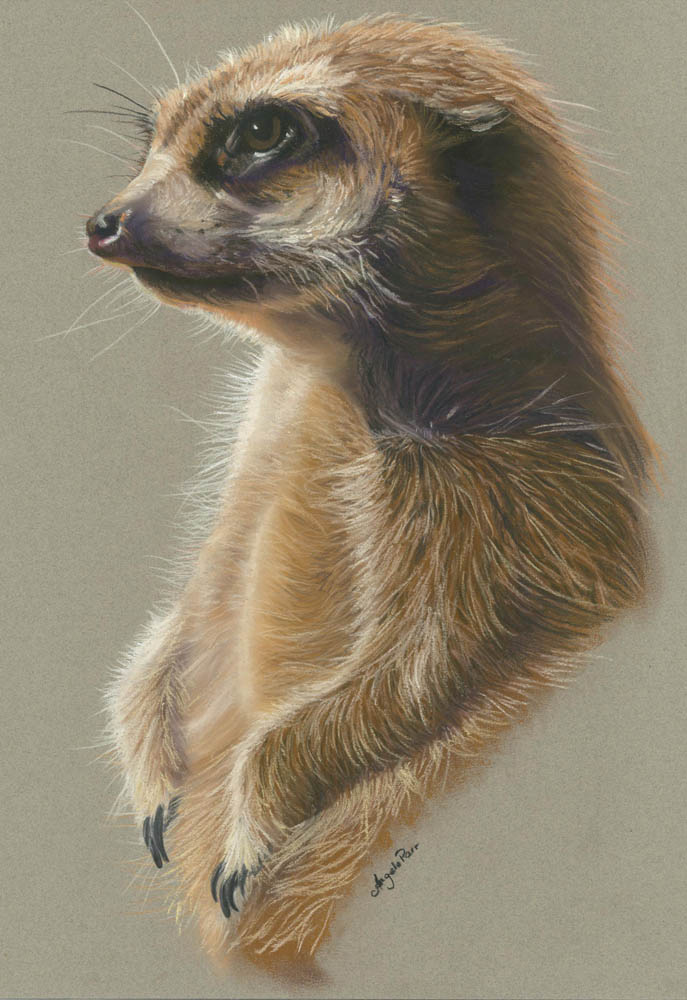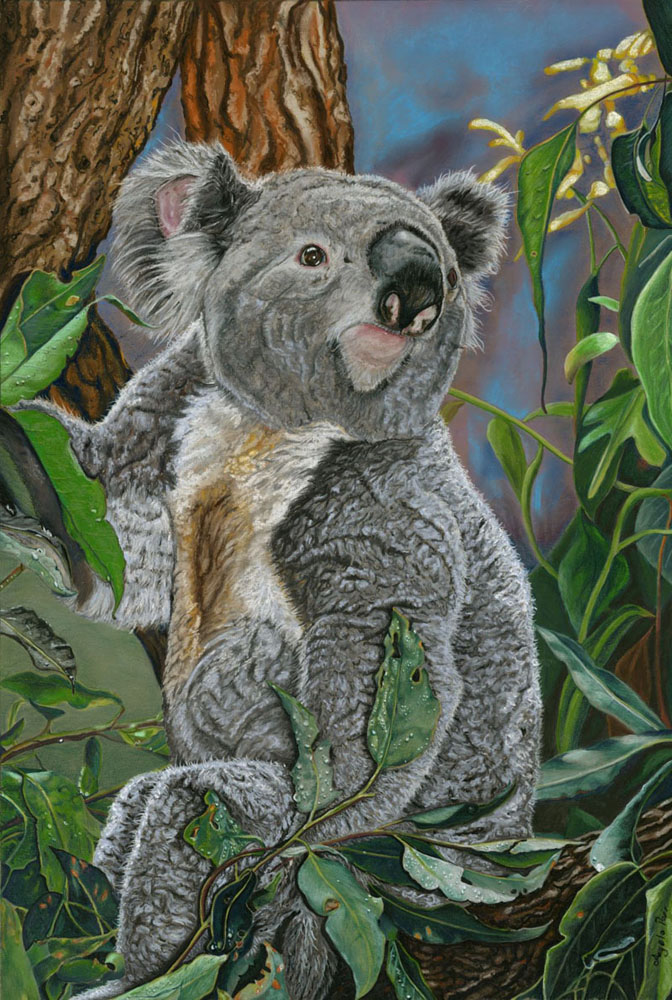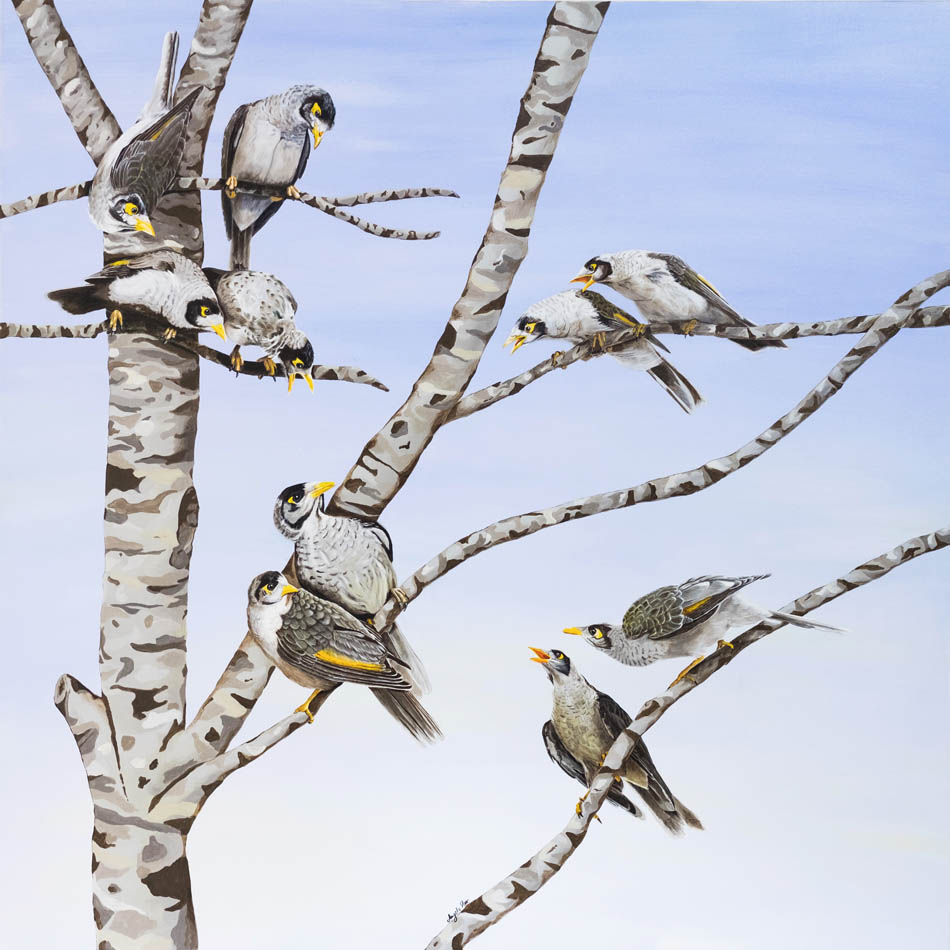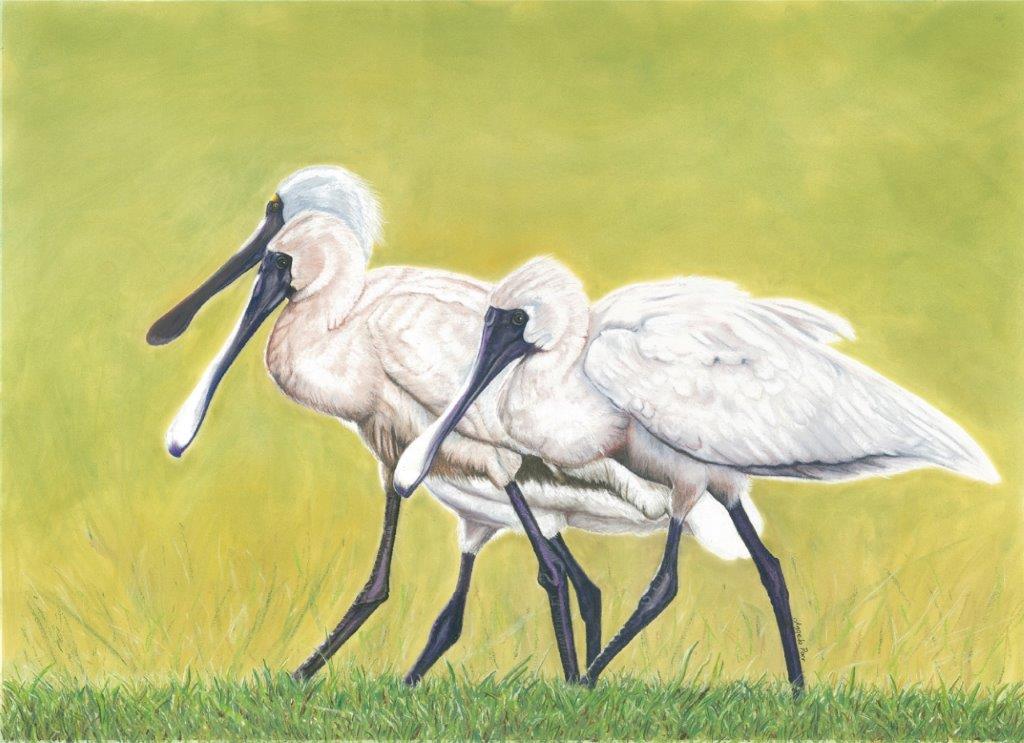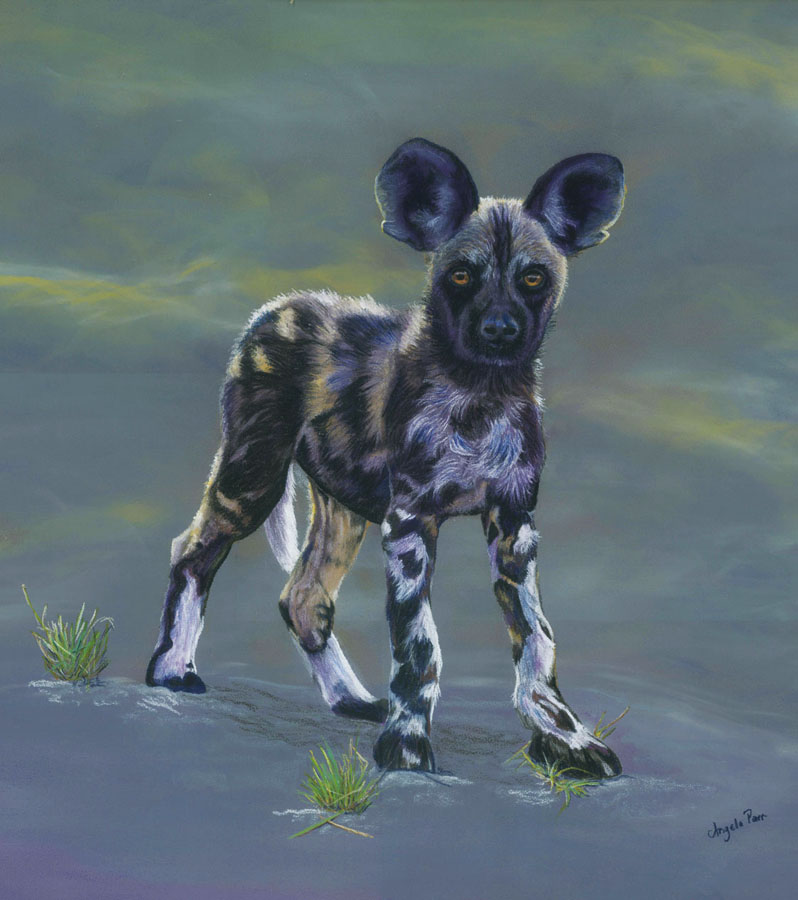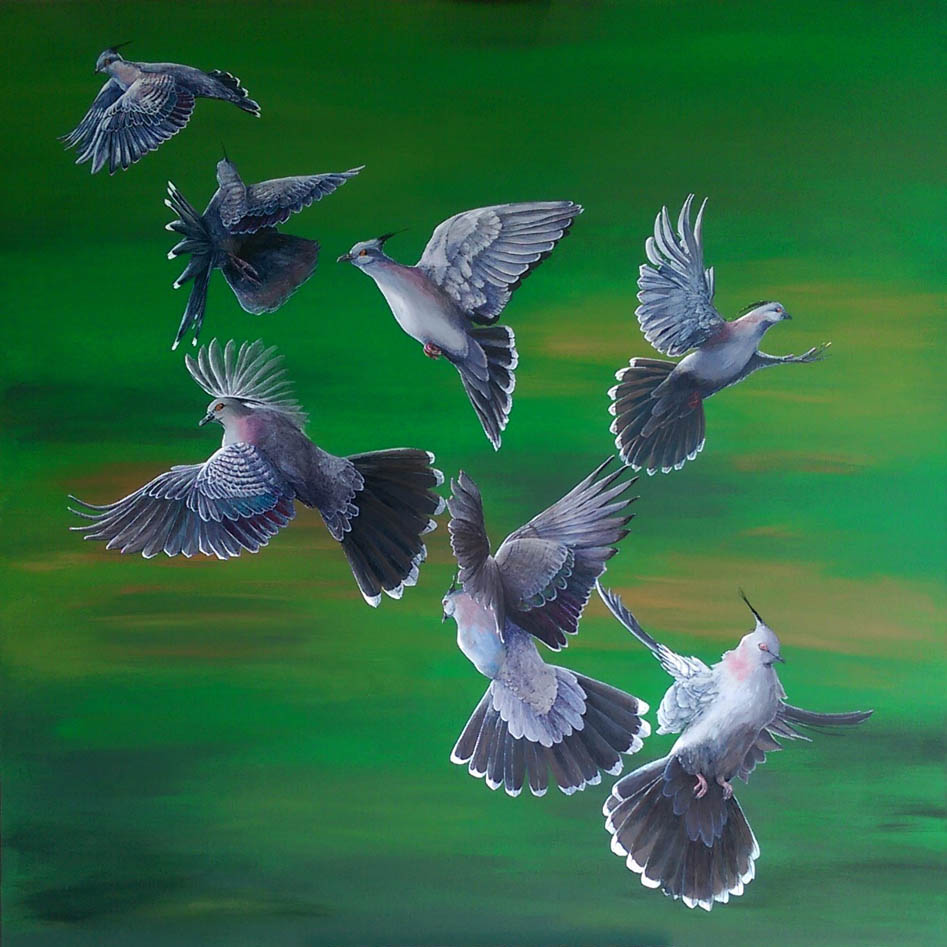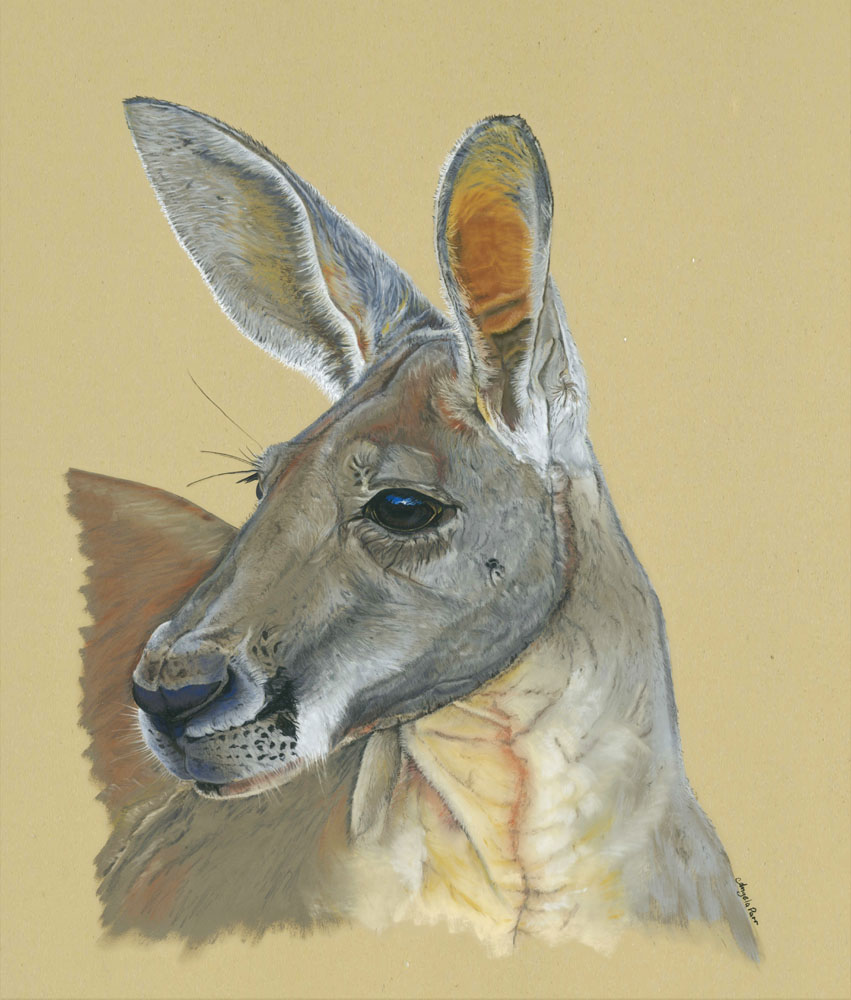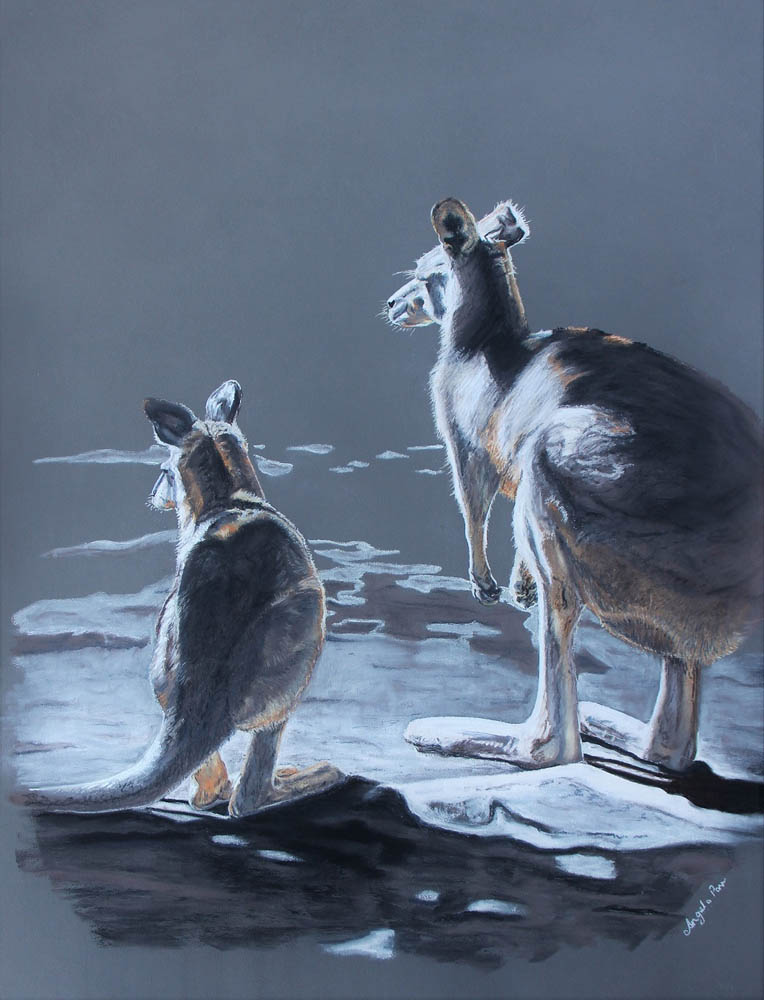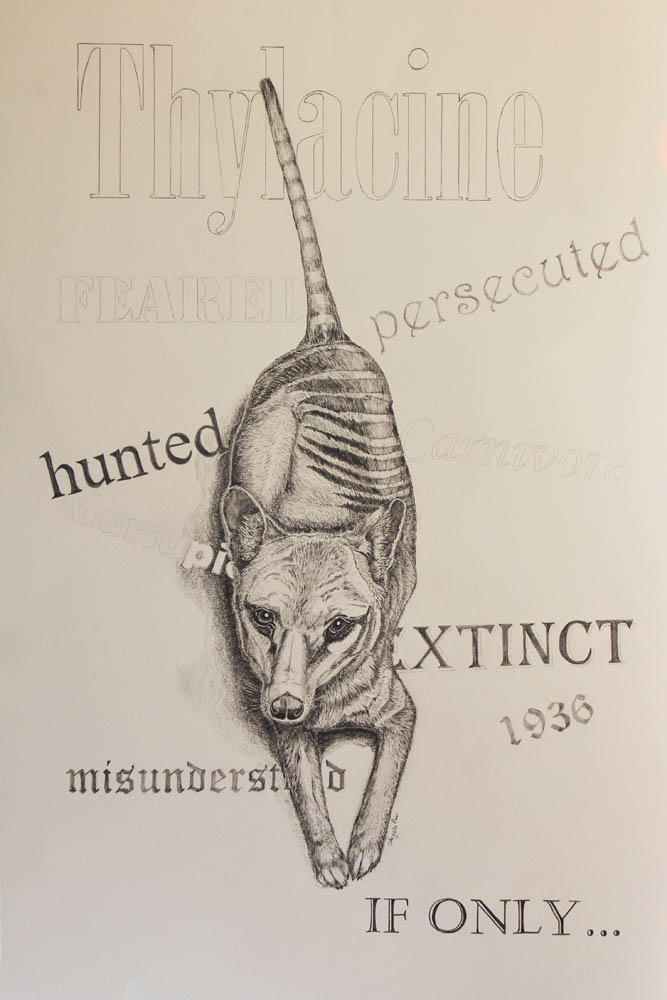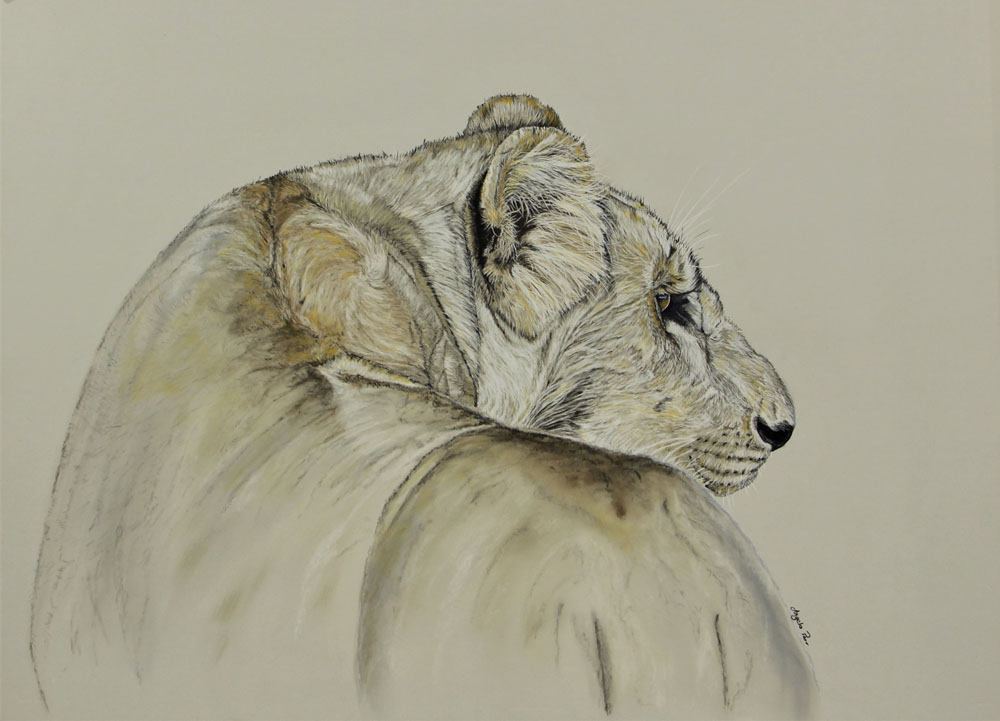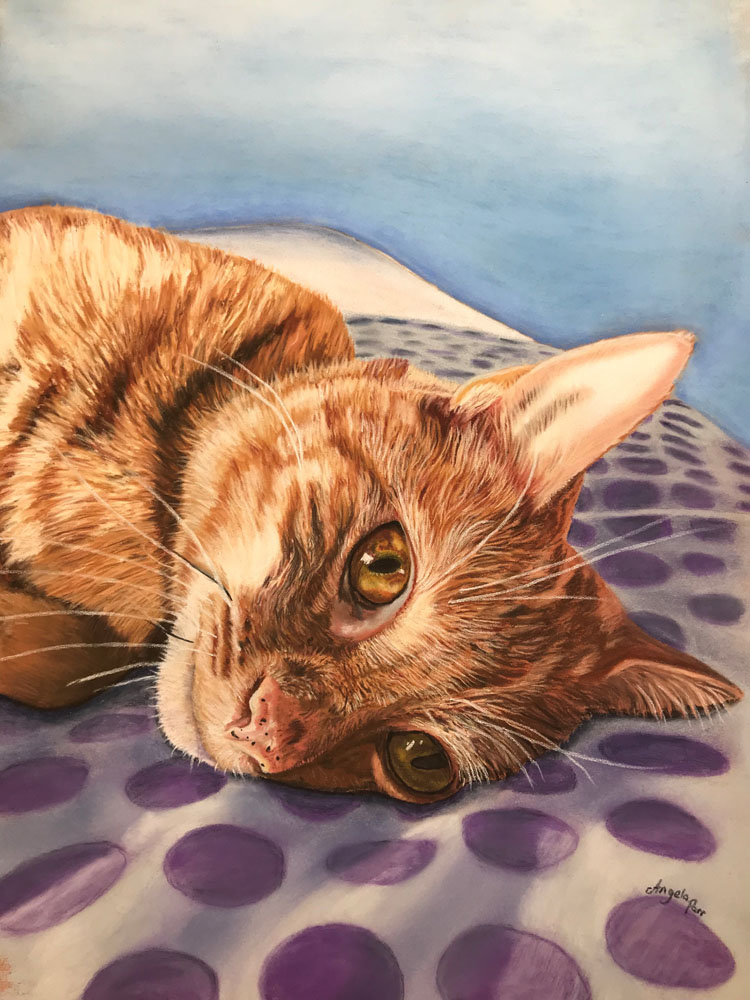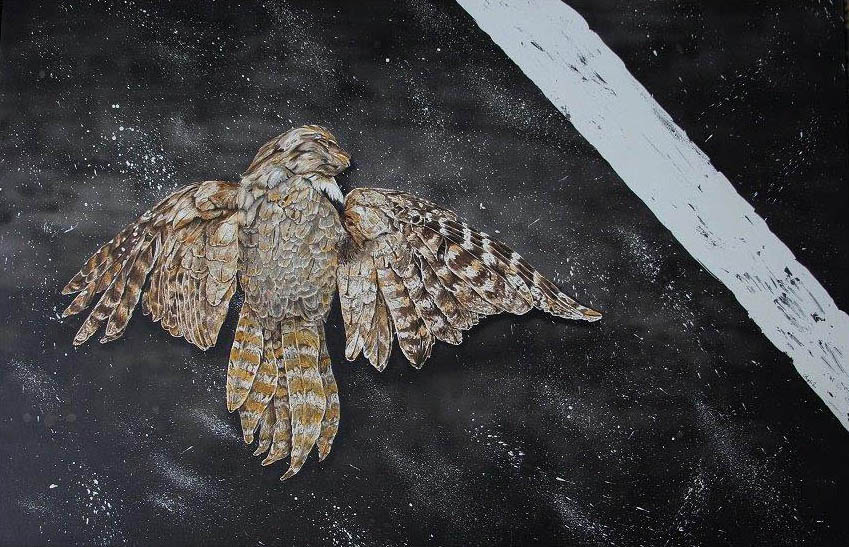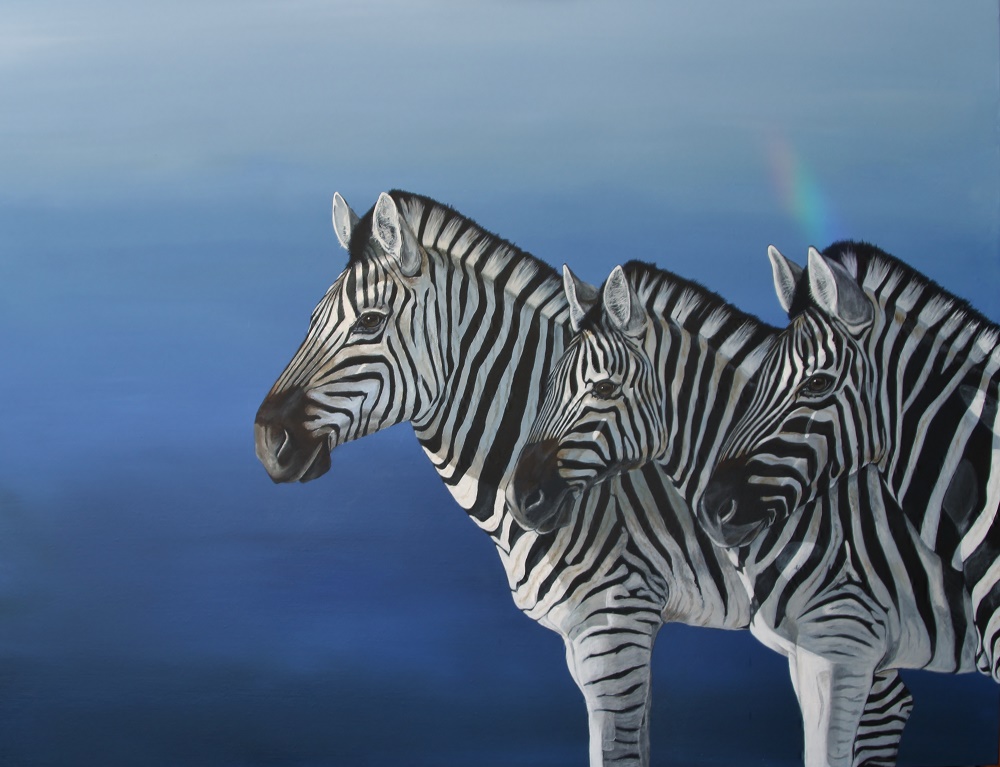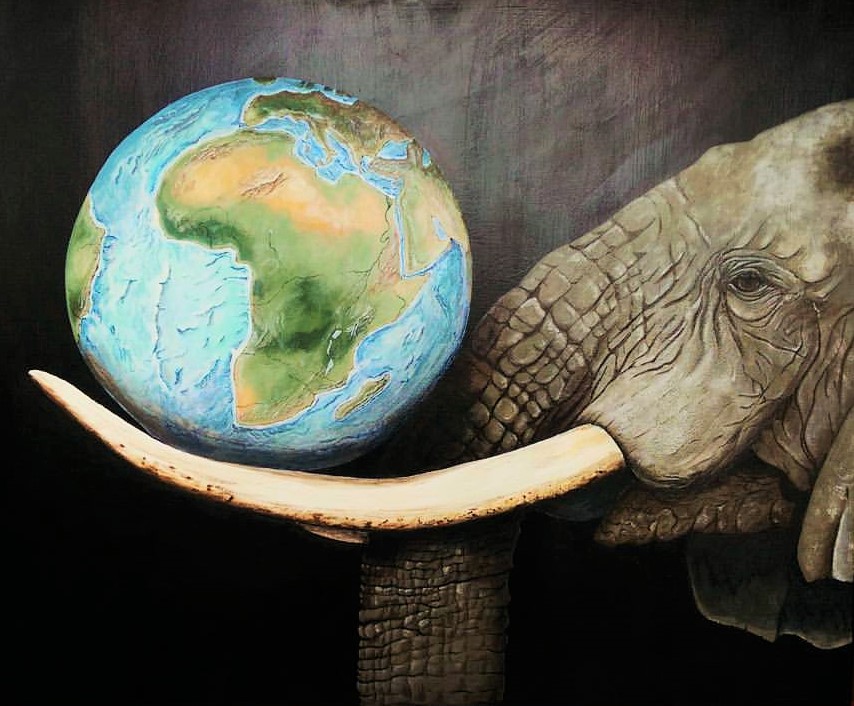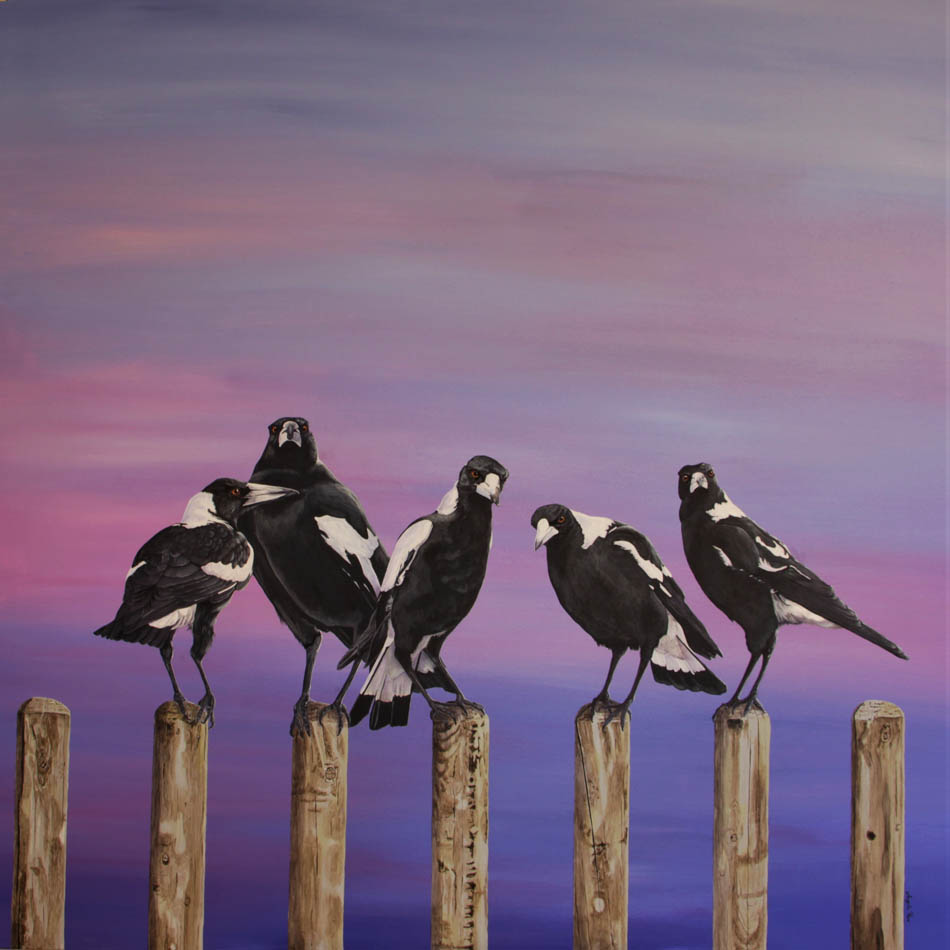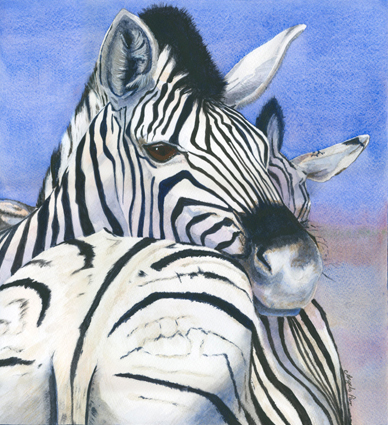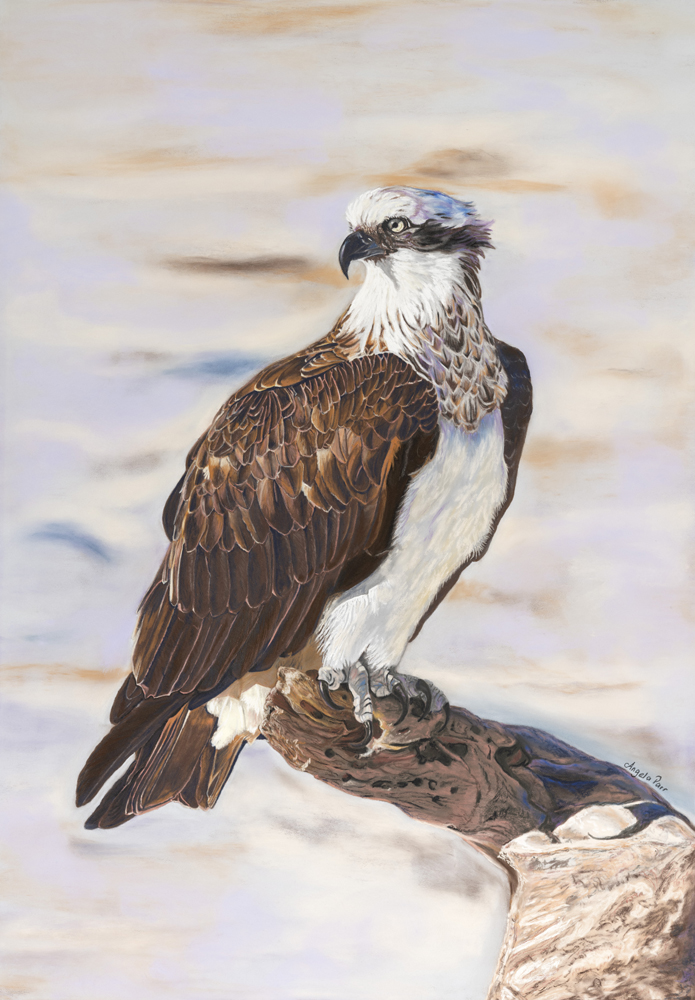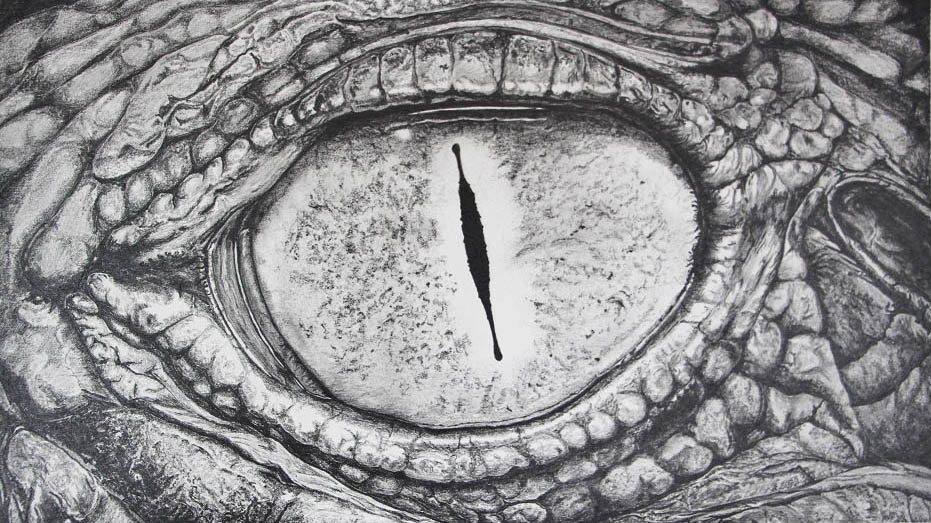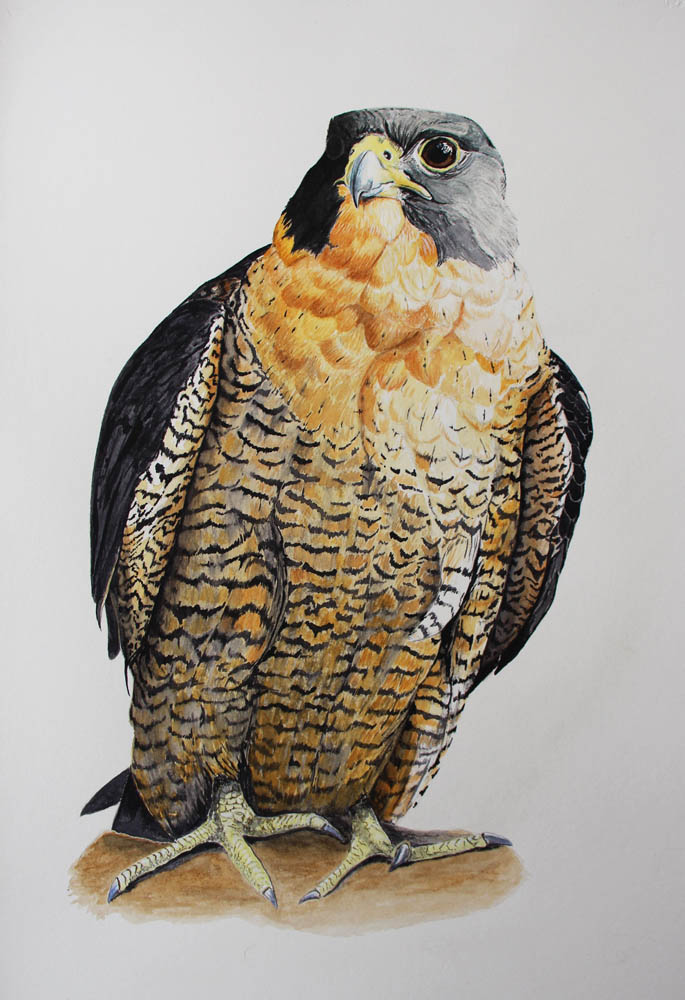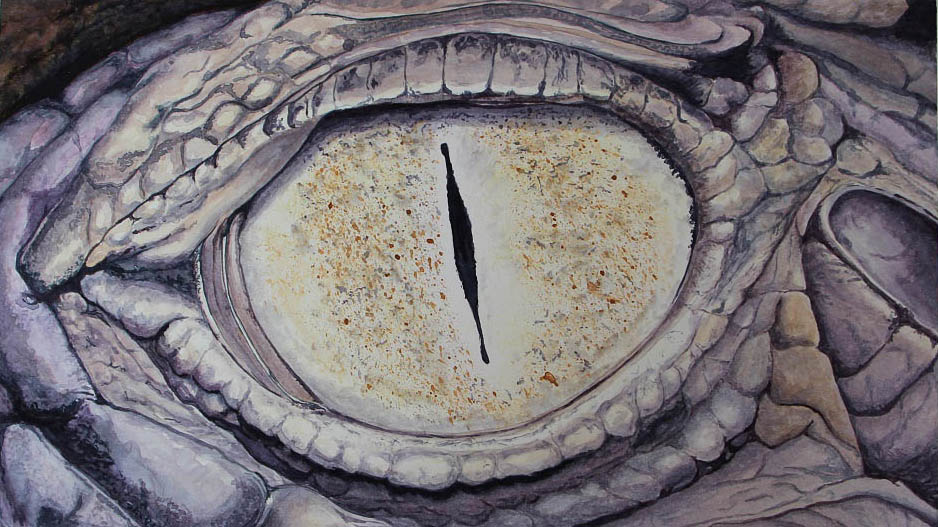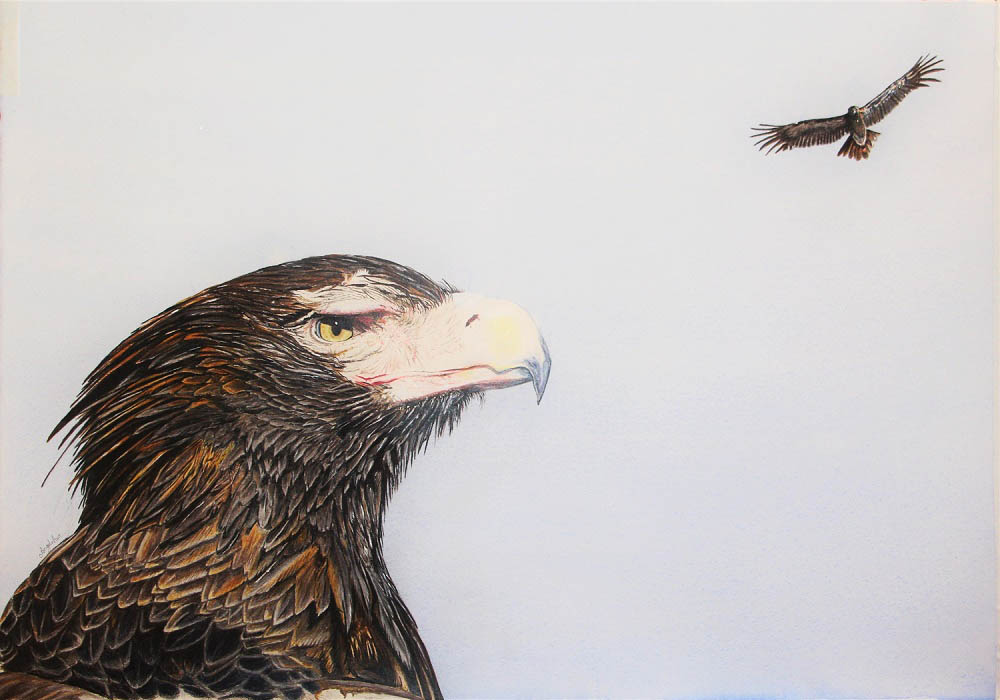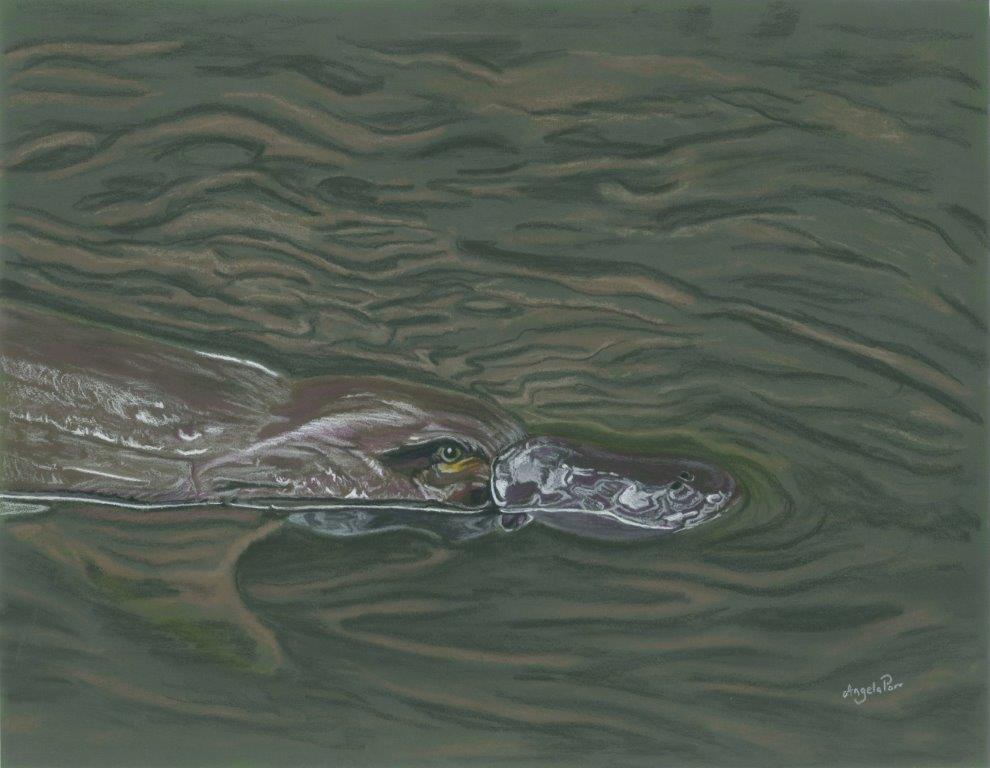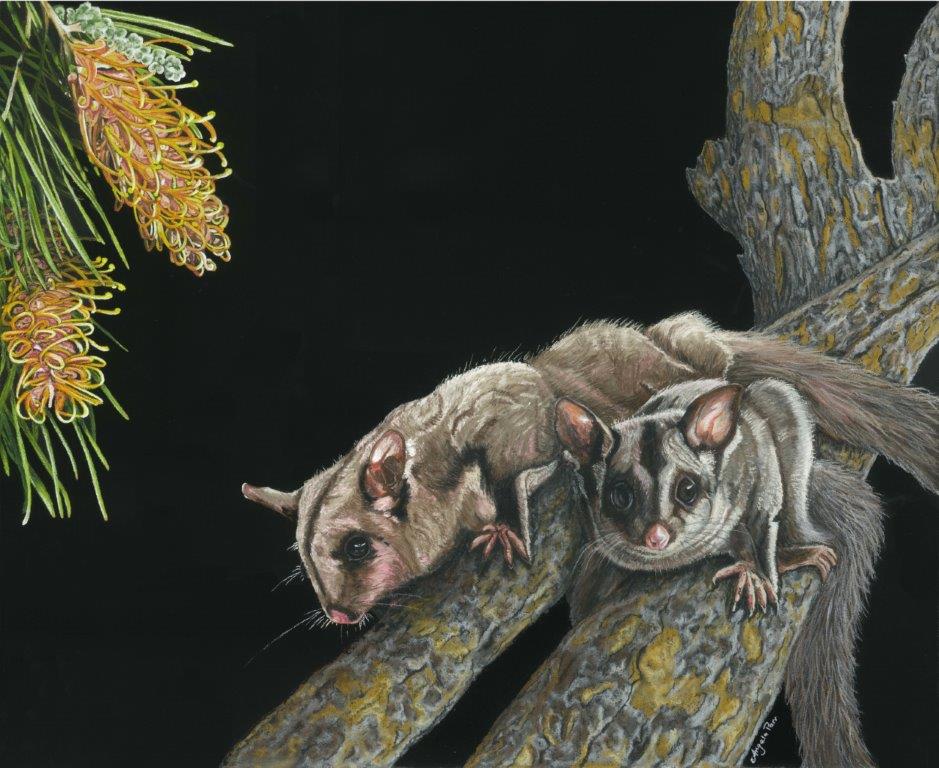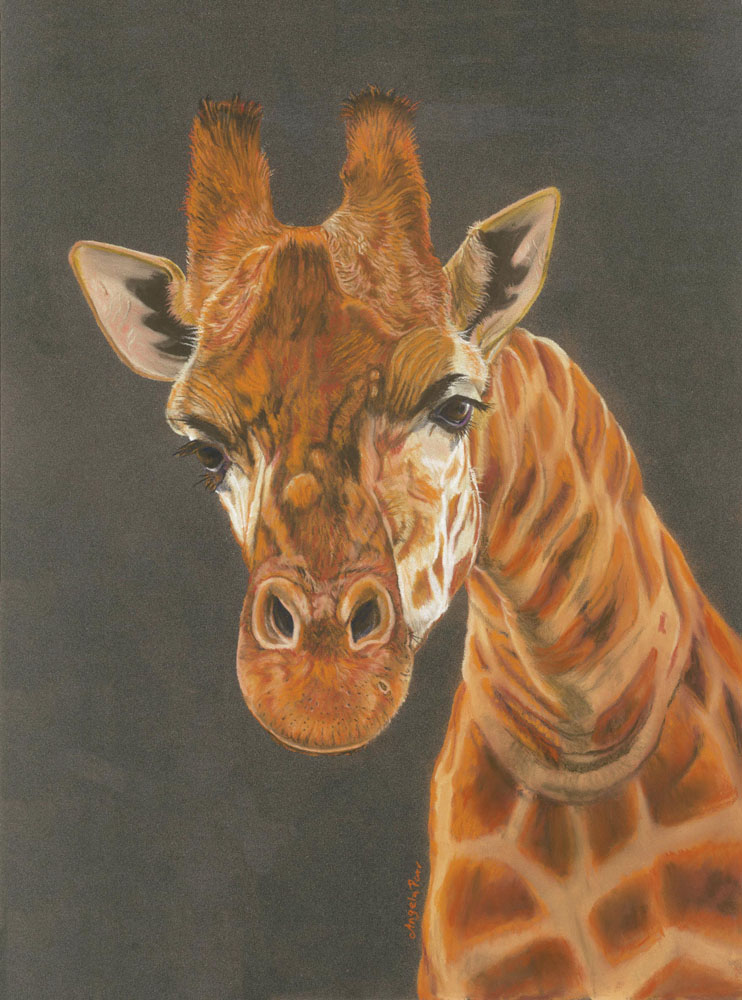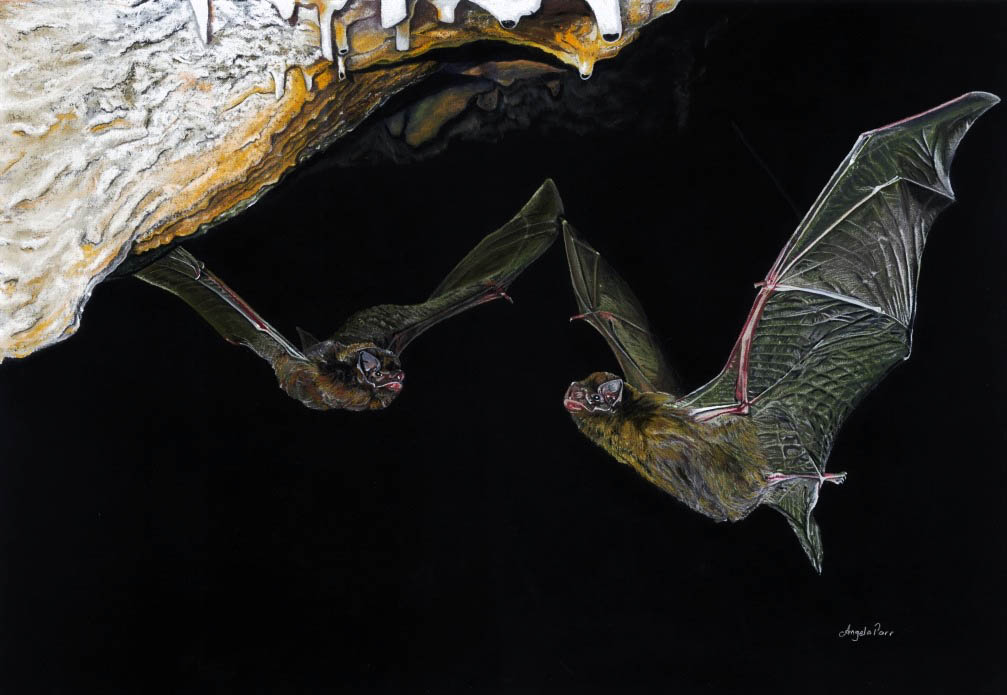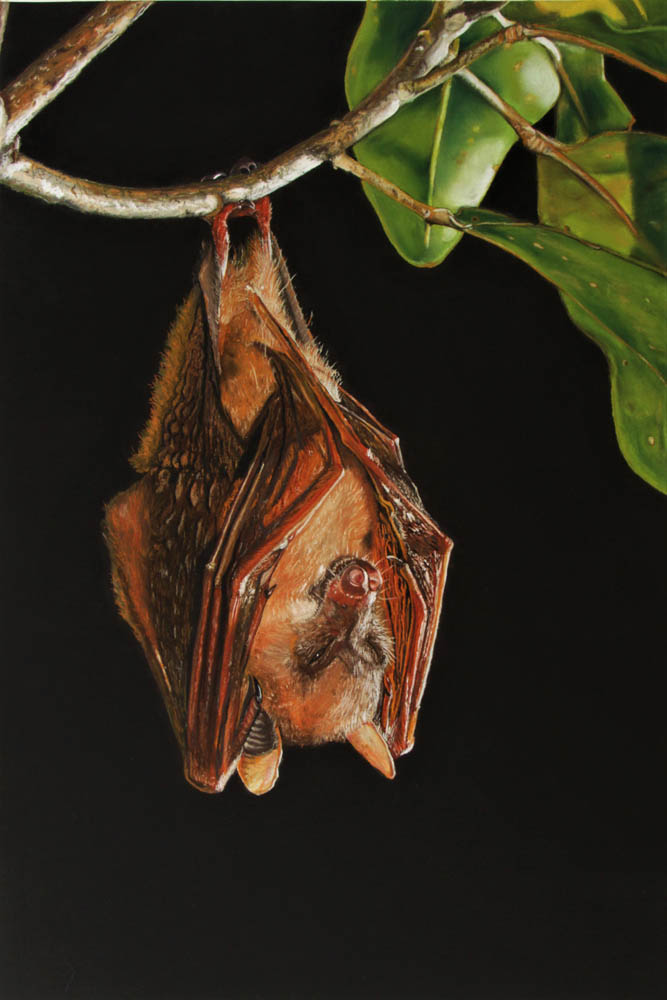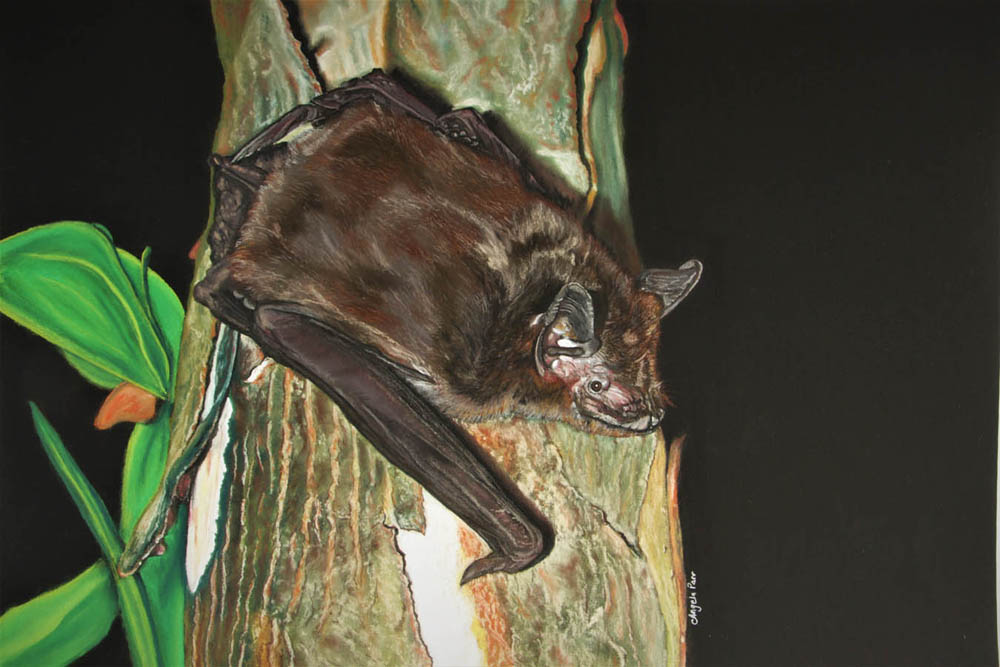Shop
-
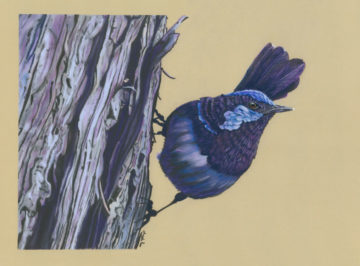
A Split Second
Pastel on Pastelmat Board (Sold)
48 cm W x 38 cm H
Adult male Superb Fairy-wrens (Malurus cyaneus) are among the most brightly coloured of the species, especially during the breeding season. These ‘coloured’ males are often accompanied by a band of brown ‘jenny wrens’, assumed to be a harem of females, but often include immature males which have not yet attained their breeding plumage. Seen in most habitat types where suitable dense cover and low shrubs occur, including urban parks and gardens, they can be seen in small social groups. These groups normally consist of one male and several females and young birds. They feed on insects and other small arthropods, which are caught mostly on the ground, but may also be taken from low bushes. This artwork depicts a male in the waning evening light about to launch on unsuspecting prey.Read moreA Split Second
Pastel on Pastelmat Board (Sold)
48 cm W x 38 cm H
Adult male Superb Fairy-wrens (Malurus cyaneus) are among the most brightly coloured of the species, especially during the breeding season. These ‘coloured’ males are often accompanied by a band of brown ‘jenny wrens’, assumed to be a harem of females, but often include immature males which have not yet attained their breeding plumage. Seen in most habitat types where suitable dense cover and low shrubs occur, including urban parks and gardens, they can be seen in small social groups. These groups normally consist of one male and several females and young birds. They feed on insects and other small arthropods, which are caught mostly on the ground, but may also be taken from low bushes. This artwork depicts a male in the waning evening light about to launch on unsuspecting prey.Quick View -
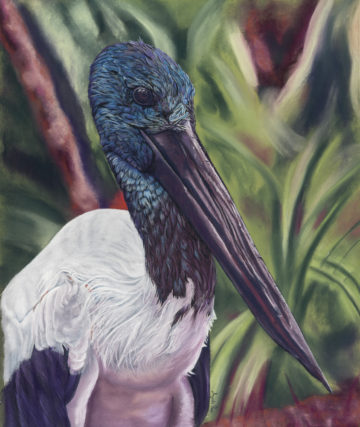
Jabiru Dreaming
Pastel on Mi Tientes Tex ($POA)
41 cm W x 51 cm H
The Black-necked Stork (formerly referred to as the Jabiru) (Ephippiorhynchus asiaticusis) is Australia’s only native stork, with numbers at approximately 10,000 birds. They are threatened by habitat destruction, the draining of shallow wetlands, disturbance at nests, overfishing, pollution, collision with electricity wires and hunting. Several breeding pairs have recently been spotted as far south as the northern river areas of NSW, the Bundjalung area where I live. My father-in-law loves these birds and asked me to paint him one. Their black-neck name is misleading, as although their bodies are black and white, their necks shine a radiant glossy dark green and purple in the sunlight. They have a massive black bill and striking long coral-red legs. The males have black eyes whilst the female’s eye is yellow. This fellow is obviously a male and was hunting in the shallow waters of Chickiba Lake in Ballina, NSW.Read moreJabiru Dreaming
Pastel on Mi Tientes Tex ($POA)
41 cm W x 51 cm H
The Black-necked Stork (formerly referred to as the Jabiru) (Ephippiorhynchus asiaticusis) is Australia’s only native stork, with numbers at approximately 10,000 birds. They are threatened by habitat destruction, the draining of shallow wetlands, disturbance at nests, overfishing, pollution, collision with electricity wires and hunting. Several breeding pairs have recently been spotted as far south as the northern river areas of NSW, the Bundjalung area where I live. My father-in-law loves these birds and asked me to paint him one. Their black-neck name is misleading, as although their bodies are black and white, their necks shine a radiant glossy dark green and purple in the sunlight. They have a massive black bill and striking long coral-red legs. The males have black eyes whilst the female’s eye is yellow. This fellow is obviously a male and was hunting in the shallow waters of Chickiba Lake in Ballina, NSW.Quick View -
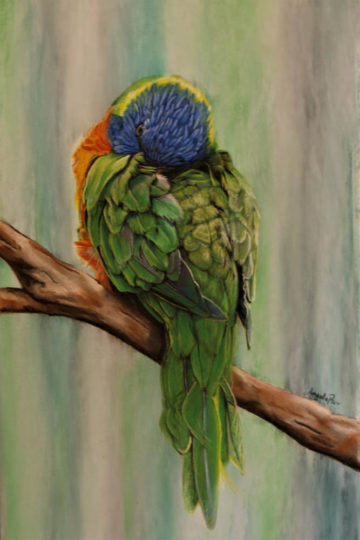
Just a Little to the Left
Pastel on Mi Tientes Tex (Sold)
45 cm W x 68 cm H
The Rainbow Lorikeet (Trichoglossus moluccanusis) is found in a wide range of treed habitats including rainforest and woodlands. It has also acclimatised well to urbanisation and is commonly encountered in well-treed suburbs. They are nectar and pollen feeders and if you look inside a lorikeet’s mouth, you’ll notice that their tongues have uniquely adapted “brushes” on the tips to help them harvest these foods from the plants in their environment. The Rainbow Lorikeet also eats fruits, seeds and some insects. Plant grevilleas and other native flowering bushes in your backyard to attract them, rather than offering honey-coated bread which is extremely unhealthy for them. They are colourful, noisy and cheeky by nature so it’s rare to see them in a quiet grooming pose such as this one.Read moreJust a Little to the Left
Pastel on Mi Tientes Tex (Sold)
45 cm W x 68 cm H
The Rainbow Lorikeet (Trichoglossus moluccanusis) is found in a wide range of treed habitats including rainforest and woodlands. It has also acclimatised well to urbanisation and is commonly encountered in well-treed suburbs. They are nectar and pollen feeders and if you look inside a lorikeet’s mouth, you’ll notice that their tongues have uniquely adapted “brushes” on the tips to help them harvest these foods from the plants in their environment. The Rainbow Lorikeet also eats fruits, seeds and some insects. Plant grevilleas and other native flowering bushes in your backyard to attract them, rather than offering honey-coated bread which is extremely unhealthy for them. They are colourful, noisy and cheeky by nature so it’s rare to see them in a quiet grooming pose such as this one.Quick View -
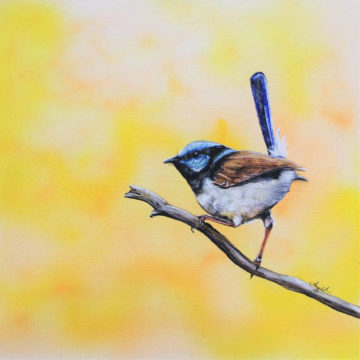
Little Boy Blue
Watercolour on board (Sold)
35 cm W x 30 cm H
Another Superb Fairy-Wren (Malurus cyaneus) this time outside of breeding season. It’s their sky blue-coloured caps, which become iridescent during breeding season. Much loved among Australians, the fairy-wren can be found all across south-east Australia and enjoys a shrubby understorey where they move about in small groups. New research has revealed that male fairy-wrens sing to their eggs and their chicks come out recognising their parent’s unique song. This small study made good use of a vibrant yellow background to really highlight the wren’s colouration.Read moreLittle Boy Blue
Watercolour on board (Sold)
35 cm W x 30 cm H
Another Superb Fairy-Wren (Malurus cyaneus) this time outside of breeding season. It’s their sky blue-coloured caps, which become iridescent during breeding season. Much loved among Australians, the fairy-wren can be found all across south-east Australia and enjoys a shrubby understorey where they move about in small groups. New research has revealed that male fairy-wrens sing to their eggs and their chicks come out recognising their parent’s unique song. This small study made good use of a vibrant yellow background to really highlight the wren’s colouration.Quick View -
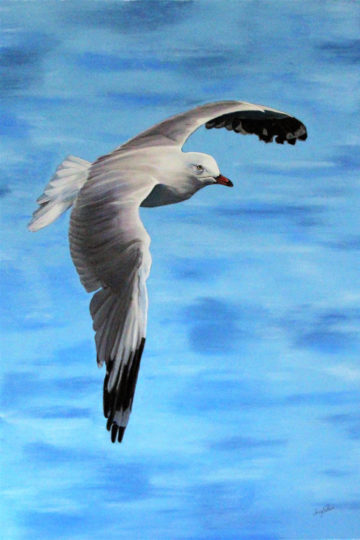
Jonathan Soaring
Pastel on Mi Tientes Tex ($POA)
68 cm W x 88 cm H
I was obsessed with the book Jonathan Livingston Seagull during my youth and even named our son Fletcher after one of the characters in Richard Bach’s fable novella. The common Silver Gull (Chroicocephalus novaehollandiae) is easily the most recognisable of all seagulls, although sadly it is also widely castigated as a voracious and persistent scavenger. The saying “Like a seagull on a hot chip” speaks of this characteristic. Their kleptoparasitic behaviour, and explosion in numbers since the 1950’s is due to the large quantities of food waste that Australians now produce. Their “natural diet” includes worms, fish, insects, and crustaceans. They are a clean and attractive bird and to see them soaring on the coastal breezes, like this one is doing, reminds us of how stunning they really are.Read moreJonathan Soaring
Pastel on Mi Tientes Tex ($POA)
68 cm W x 88 cm H
I was obsessed with the book Jonathan Livingston Seagull during my youth and even named our son Fletcher after one of the characters in Richard Bach’s fable novella. The common Silver Gull (Chroicocephalus novaehollandiae) is easily the most recognisable of all seagulls, although sadly it is also widely castigated as a voracious and persistent scavenger. The saying “Like a seagull on a hot chip” speaks of this characteristic. Their kleptoparasitic behaviour, and explosion in numbers since the 1950’s is due to the large quantities of food waste that Australians now produce. Their “natural diet” includes worms, fish, insects, and crustaceans. They are a clean and attractive bird and to see them soaring on the coastal breezes, like this one is doing, reminds us of how stunning they really are.Quick View -

Ponderings
Pastel on Pastelmat (Sold)
63 cm W x 83 cm H
My hometown has an abundance of Australian pelicans (Pelecanus conspicillatus), and in fact the Australia Seabird Rescue was founded and based here through the conservation work of a wonderful man Lance Ferris, whom locals affectionately knew as “The Pelican Man”. Lance’s work started in 1992 after he noticed many pelicans injured by fishing line and hooks. Pelicans were rescued, rehabilitated, and released. His work soon extended from pelicans to other coastal birds as well as marine turtles. As I was involved in Bird Rehabilitation myself at the time, I often crossed paths with Lance. He was passionate about educating the community, especially school children and fisher-folk, to preserve and protect the coastal environment and all marine wildlife. Australian Seabird Rescue (one of my chosen charities) now works around Australia to protect and rescue seabirds and shorebirds. Seeing pelicans serenely gliding along our waterways, still gives me great delight.Read morePonderings
Pastel on Pastelmat (Sold)
63 cm W x 83 cm H
My hometown has an abundance of Australian pelicans (Pelecanus conspicillatus), and in fact the Australia Seabird Rescue was founded and based here through the conservation work of a wonderful man Lance Ferris, whom locals affectionately knew as “The Pelican Man”. Lance’s work started in 1992 after he noticed many pelicans injured by fishing line and hooks. Pelicans were rescued, rehabilitated, and released. His work soon extended from pelicans to other coastal birds as well as marine turtles. As I was involved in Bird Rehabilitation myself at the time, I often crossed paths with Lance. He was passionate about educating the community, especially school children and fisher-folk, to preserve and protect the coastal environment and all marine wildlife. Australian Seabird Rescue (one of my chosen charities) now works around Australia to protect and rescue seabirds and shorebirds. Seeing pelicans serenely gliding along our waterways, still gives me great delight.Quick View -
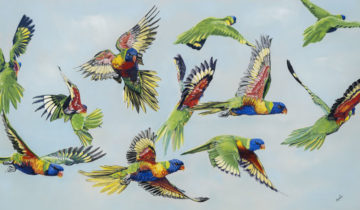
Rainbows Take Flight
Pastel on Pastelmat board ($POA)
94 cm W x 54 cm H
Loud, belligerent colonies of rainbow lorikeets (Trichoglossus moluccanus) are the soundtrack of urban Australia. They are often seen in fast-moving screeching flocks or gathering in huge, noisy numbers inhabiting large blossoming trees in local parks or backyards. The noise can be deafening. In many places, including campsites and suburban gardens, wild lorikeets are so used to humans that they can be hand-fed, although many people, ignorant of their dietary requirements, feed them bread or bread coated with honey. This is an inadequate source of the nutrients, vitamins and minerals that the rainbow lorikeet requires and can lead to health and feather formation issues in young lorikeets. Sadly, this is just another example of how human interaction can negatively affect our precious wildlife. I have created this artwork from a compilation of images, intending to show the rainbow lorikeets’ unmistakable patchwork of colours in a variety of flight positions and focus.Read moreRainbows Take Flight
Pastel on Pastelmat board ($POA)
94 cm W x 54 cm H
Loud, belligerent colonies of rainbow lorikeets (Trichoglossus moluccanus) are the soundtrack of urban Australia. They are often seen in fast-moving screeching flocks or gathering in huge, noisy numbers inhabiting large blossoming trees in local parks or backyards. The noise can be deafening. In many places, including campsites and suburban gardens, wild lorikeets are so used to humans that they can be hand-fed, although many people, ignorant of their dietary requirements, feed them bread or bread coated with honey. This is an inadequate source of the nutrients, vitamins and minerals that the rainbow lorikeet requires and can lead to health and feather formation issues in young lorikeets. Sadly, this is just another example of how human interaction can negatively affect our precious wildlife. I have created this artwork from a compilation of images, intending to show the rainbow lorikeets’ unmistakable patchwork of colours in a variety of flight positions and focus.Quick View -
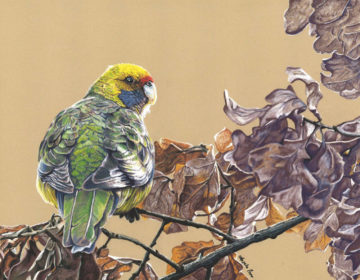
Is This My Best Side?
Pastel on Pastelmat board ($POA)
55 cm W x 46 cm H
The green rosella or Tasmanian rosella (Platycercus caledonicus) is a species of parrot native to Tasmania and Bass Strait islands. Found in a wide range of habitats with some form of tree cover, the green rosella is predominantly herbivorous, consuming seeds, berries, nuts and fruit, as well as flowers, but may also eat insect larvae and insects such as psyllids. Their nesting site is usually a hollow over 1 m deep in a tree trunk anywhere up to 30 m above the ground. Chimneys, holes in walls and even the vertical pipes of tennis court fences have been used. Green rosellas nested in a wall cavity at Port Arthur convict prison site in 1958 and 2009, which is where this bird was spotted.Read moreIs This My Best Side?
Pastel on Pastelmat board ($POA)
55 cm W x 46 cm H
The green rosella or Tasmanian rosella (Platycercus caledonicus) is a species of parrot native to Tasmania and Bass Strait islands. Found in a wide range of habitats with some form of tree cover, the green rosella is predominantly herbivorous, consuming seeds, berries, nuts and fruit, as well as flowers, but may also eat insect larvae and insects such as psyllids. Their nesting site is usually a hollow over 1 m deep in a tree trunk anywhere up to 30 m above the ground. Chimneys, holes in walls and even the vertical pipes of tennis court fences have been used. Green rosellas nested in a wall cavity at Port Arthur convict prison site in 1958 and 2009, which is where this bird was spotted.Quick View -
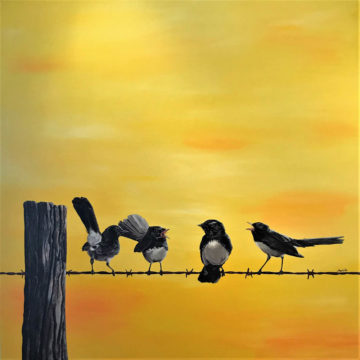
A Bunch of Wags
Acrylic on canvas (Sold)
122 cm W x 122 cm H
Willy Wagtails (Rhipidura leucophrys) belong to the group of birds affectionately known in birding circles as the ‘Black and Whites’, our common backyard birds. They are small and engaging with their constant sideways wagging of their fantail which earned them the name wagtail. Willie Wagtails feature prominently in indigenous mythology and were disliked by Indigenous people in some areas, as they were thought to loiter at the edge of camps, listening to conversations then telling the secrets elsewhere. The Willie Wagtail was also seen as an ill omen, and they would abandon an expedition if a Willie Wagtail was seen on the morning of departure. This artwork depicts their chattering nature almost as though they are telling each other off, or perhaps sharing THAT secret!Read moreA Bunch of Wags
Acrylic on canvas (Sold)
122 cm W x 122 cm H
Willy Wagtails (Rhipidura leucophrys) belong to the group of birds affectionately known in birding circles as the ‘Black and Whites’, our common backyard birds. They are small and engaging with their constant sideways wagging of their fantail which earned them the name wagtail. Willie Wagtails feature prominently in indigenous mythology and were disliked by Indigenous people in some areas, as they were thought to loiter at the edge of camps, listening to conversations then telling the secrets elsewhere. The Willie Wagtail was also seen as an ill omen, and they would abandon an expedition if a Willie Wagtail was seen on the morning of departure. This artwork depicts their chattering nature almost as though they are telling each other off, or perhaps sharing THAT secret!Quick View -
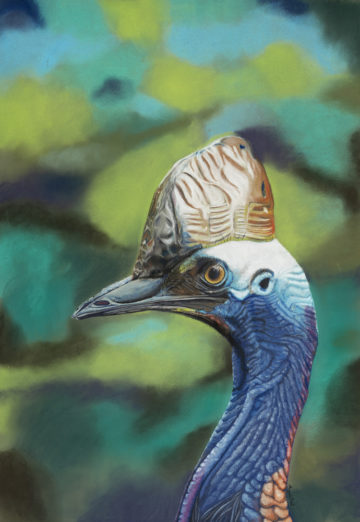
Wrinkles
Pastel on Canson paper (Sold)
47 cm W x 66 cm H
“Wrinkles” lives in the Daintree in far north Queensland, along with other Southern Cassowaries, (Casuarius casuarius). They are an icon of tourism in this area, but sadly are now endangered due to habitat loss, and threats from motor vehicles, dog packs, feral pigs and disease. Cassowaries are integral for the health of our Tropical rainforests due to seed dispersal of between 70 to 100 plant species. It is vital that this bird’s unique future is secured. Cassowaries have striking colours and “helmets” known as casques and I hoped to give homage to this in my pastel rendition.Read moreWrinkles
Pastel on Canson paper (Sold)
47 cm W x 66 cm H
“Wrinkles” lives in the Daintree in far north Queensland, along with other Southern Cassowaries, (Casuarius casuarius). They are an icon of tourism in this area, but sadly are now endangered due to habitat loss, and threats from motor vehicles, dog packs, feral pigs and disease. Cassowaries are integral for the health of our Tropical rainforests due to seed dispersal of between 70 to 100 plant species. It is vital that this bird’s unique future is secured. Cassowaries have striking colours and “helmets” known as casques and I hoped to give homage to this in my pastel rendition.Quick View -
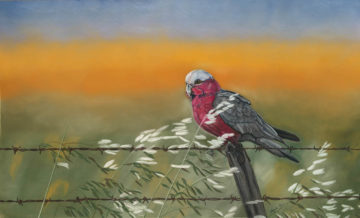
A Breezy Perch
Pastel on Canson paper (Sold)
86 cm W x 60 cm H
The galah (Eolophus roseicapilla), also known as the pink and grey cockatoo or rose-breasted cockatoo, is among the most common of the cockatoos. With its distinctive pink and grey plumage and its bold and loud behaviour, it is a familiar sight in the wild and increasingly in urban areas. Like other cockatoos, the Galah is an excellent mimic of voices and sounds. Add this to their bright colour and hilarious personalities, as they are often seen hanging upside-down on a telegraph line, bobbing their heads in a dance, or playing soccer with pebbles on the ground, you will understand why ‘galah’ is Aussie slang for a silly person. The galah is often found in flocks of 10 to 1,000 individuals, and rarely is it seen on its own like this one enjoying the country breeze on a typical outback fence.Read moreA Breezy Perch
Pastel on Canson paper (Sold)
86 cm W x 60 cm H
The galah (Eolophus roseicapilla), also known as the pink and grey cockatoo or rose-breasted cockatoo, is among the most common of the cockatoos. With its distinctive pink and grey plumage and its bold and loud behaviour, it is a familiar sight in the wild and increasingly in urban areas. Like other cockatoos, the Galah is an excellent mimic of voices and sounds. Add this to their bright colour and hilarious personalities, as they are often seen hanging upside-down on a telegraph line, bobbing their heads in a dance, or playing soccer with pebbles on the ground, you will understand why ‘galah’ is Aussie slang for a silly person. The galah is often found in flocks of 10 to 1,000 individuals, and rarely is it seen on its own like this one enjoying the country breeze on a typical outback fence.Quick View -
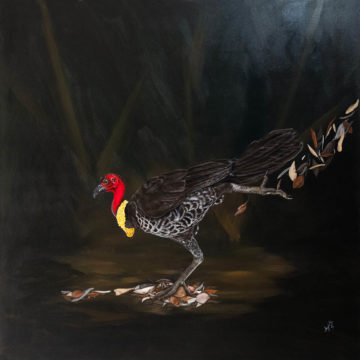
A Brush with Death
Acrylic on canvas (sold)
122 cm W x 122 cm H
Never has a bird so divided the opinions of visitors coming to my gallery as this Brush Turkey. The Australian Brush Turkey (Alectura lathami), also known as the bush or scrub turkey, has a bad reputation. They are blamed for damaging gardens (making an awful mess as it digs up leaf litter, twigs and dirt to build its egg mound) and darting across roads. Found in eastern Australia from Far North Queensland to the Illawarra in New South Wales, they’ve managed to adapt to life in cities and have also been introduced to Kangaroo Island in South Australia. Brush turkey nests or ‘mounds’ are the size of a car and are made up of soil and plant material. Built by the males to attract a mate, they’re essentially large compost heaps, that take the hard-working male about a month to create.
These mounds generate a huge amount of heat and that’s what incubates the eggs — which is lucky because once the eggs are laid the mother is off, and the father only sticks around to defend the mound. When the chicks have left the nest, the leftover mound is a perfect bit of compost for humans to spread out over the garden.Read moreA Brush with Death
Acrylic on canvas (sold)
122 cm W x 122 cm H
Never has a bird so divided the opinions of visitors coming to my gallery as this Brush Turkey. The Australian Brush Turkey (Alectura lathami), also known as the bush or scrub turkey, has a bad reputation. They are blamed for damaging gardens (making an awful mess as it digs up leaf litter, twigs and dirt to build its egg mound) and darting across roads. Found in eastern Australia from Far North Queensland to the Illawarra in New South Wales, they’ve managed to adapt to life in cities and have also been introduced to Kangaroo Island in South Australia. Brush turkey nests or ‘mounds’ are the size of a car and are made up of soil and plant material. Built by the males to attract a mate, they’re essentially large compost heaps, that take the hard-working male about a month to create.
These mounds generate a huge amount of heat and that’s what incubates the eggs — which is lucky because once the eggs are laid the mother is off, and the father only sticks around to defend the mound. When the chicks have left the nest, the leftover mound is a perfect bit of compost for humans to spread out over the garden.Quick View -
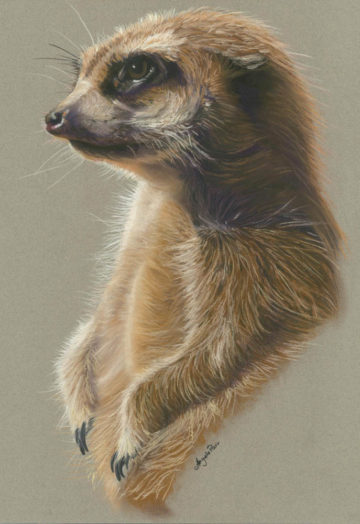
Suricate Sentinel
Pastel on Canson pastel paper (Sold)
32cm W x 45cm H
The Meerkat (Suricata suricatta) is a highly intelligent omnivore (standing only about 25 – 30cm from head to rump) found in southern Africa. The dark patches around their eyes help cut down on the sun’s glare, and their thin fur and dark skin on their stomachs assists them to control body temperature. Their diet consists of insects, lizards, birds, and fruit. When hunting small game, they work together and communicate with purring sounds. As they forage for insects and other prey, they bury their heads in the sand, so they need a reliable and trusted sentry to be on the alert for predatory snakes, hawks, eagles and jackals. This curious upright stance keeps the rest of the gang safe.Read moreSuricate Sentinel
Pastel on Canson pastel paper (Sold)
32cm W x 45cm H
The Meerkat (Suricata suricatta) is a highly intelligent omnivore (standing only about 25 – 30cm from head to rump) found in southern Africa. The dark patches around their eyes help cut down on the sun’s glare, and their thin fur and dark skin on their stomachs assists them to control body temperature. Their diet consists of insects, lizards, birds, and fruit. When hunting small game, they work together and communicate with purring sounds. As they forage for insects and other prey, they bury their heads in the sand, so they need a reliable and trusted sentry to be on the alert for predatory snakes, hawks, eagles and jackals. This curious upright stance keeps the rest of the gang safe.Quick View -
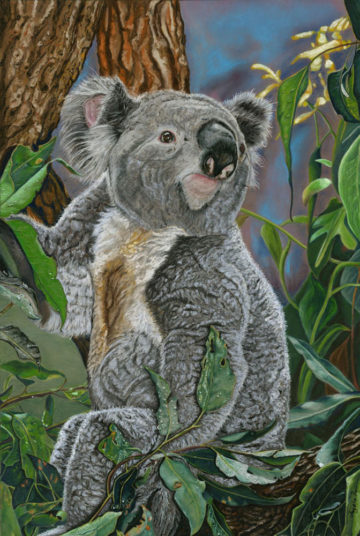
A Comfortable Seat
Pastel on Colour Fix Art Spectrum paper ($POA)
39 cm W x 58 cm H
The Koala (Phascolarctos cinereus) is an arboreal herbivorous marsupial, and an integral part of the Australian bush. They usually sleep for 20 hours a day, perched high up in eucalyptus trees. Their diet consists exclusively of these leaves, considered poisonous to most other animals. The word ‘Koala’ is thought to mean ‘no drink’ in the Australian Aboriginal language, however koalas do drink especially during heatwaves and in times of drought. Koalas are in serious danger of becoming extinct by 2050 due to deforestation, drought and bushfires.
This little guy is “Arni”, a northern koala (their fur is shorter and more silvery-grey than their southern cousins). He is a lovely gentle male, almost in his prime, who happily resides at the Byron Bay Wildlife Sanctuary, in northern NSW.Read moreA Comfortable Seat
Pastel on Colour Fix Art Spectrum paper ($POA)
39 cm W x 58 cm H
The Koala (Phascolarctos cinereus) is an arboreal herbivorous marsupial, and an integral part of the Australian bush. They usually sleep for 20 hours a day, perched high up in eucalyptus trees. Their diet consists exclusively of these leaves, considered poisonous to most other animals. The word ‘Koala’ is thought to mean ‘no drink’ in the Australian Aboriginal language, however koalas do drink especially during heatwaves and in times of drought. Koalas are in serious danger of becoming extinct by 2050 due to deforestation, drought and bushfires.
This little guy is “Arni”, a northern koala (their fur is shorter and more silvery-grey than their southern cousins). He is a lovely gentle male, almost in his prime, who happily resides at the Byron Bay Wildlife Sanctuary, in northern NSW.Quick View -
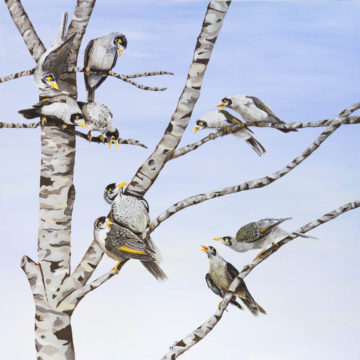
A Miner Squabble
Acrylic on canvas (Sold)
122 cm W x 122 cm H
When my children were much younger, they used to stand in our front yard waiting for the morning school bus. A tree there was usually alive with squabbling Noisy Miner birds (Manorina melanocephala) expressing ritualised displays, such as flight displays, postural displays, and facial displays. Noisy miners are particularly pugnacious honeyeaters, gregarious, bold, curious and territorial; they forage, bathe, roost, breed and defend territory communally, forming colonies that can contain several hundred birds. Each bird has an ‘activity space’, and birds with overlapping activity spaces form associations called ‘coteries’, which are the most stable units within the colony. The birds also form temporary flocks called ‘coalitions’ for specific activities, such as mobbing a predator. The noisy miner is a notably aggressive bird, so that chasing, pecking, fighting, scolding, and mobbing occur throughout the day, targeted at both intruders and colony members.Read moreA Miner Squabble
Acrylic on canvas (Sold)
122 cm W x 122 cm H
When my children were much younger, they used to stand in our front yard waiting for the morning school bus. A tree there was usually alive with squabbling Noisy Miner birds (Manorina melanocephala) expressing ritualised displays, such as flight displays, postural displays, and facial displays. Noisy miners are particularly pugnacious honeyeaters, gregarious, bold, curious and territorial; they forage, bathe, roost, breed and defend territory communally, forming colonies that can contain several hundred birds. Each bird has an ‘activity space’, and birds with overlapping activity spaces form associations called ‘coteries’, which are the most stable units within the colony. The birds also form temporary flocks called ‘coalitions’ for specific activities, such as mobbing a predator. The noisy miner is a notably aggressive bird, so that chasing, pecking, fighting, scolding, and mobbing occur throughout the day, targeted at both intruders and colony members.Quick View -
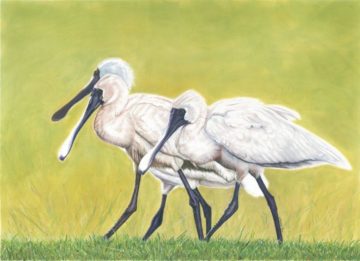
A Nest of Spoons
Pastel on Mi Tientes Tex ($POA)
87 cm W x 67 cm H
A juvenile Royal Spoonbill (Platalea regia) arrived on our property, lost and starving. We fed little “Teaspoon” the Christmas Prawn scraps before finding a suitable wetland nearby for relocation.
“Teaspoon’s” visit made me curious about Spoonbills. They are found throughout eastern and northern Australia, residing in wetlands, mudflats and grasslands. Their black spatulate bill contains papillae (vibration detectors) which help them “feel” for prey in murky water, day or night.
In breeding season the birds are very white, with a distinctive ‘nuchal’ crest on the head/neck. A yellow patch is above the eye, absent in juveniles, who are often ‘dirty’ in appearance.Read moreA Nest of Spoons
Pastel on Mi Tientes Tex ($POA)
87 cm W x 67 cm H
A juvenile Royal Spoonbill (Platalea regia) arrived on our property, lost and starving. We fed little “Teaspoon” the Christmas Prawn scraps before finding a suitable wetland nearby for relocation.
“Teaspoon’s” visit made me curious about Spoonbills. They are found throughout eastern and northern Australia, residing in wetlands, mudflats and grasslands. Their black spatulate bill contains papillae (vibration detectors) which help them “feel” for prey in murky water, day or night.
In breeding season the birds are very white, with a distinctive ‘nuchal’ crest on the head/neck. A yellow patch is above the eye, absent in juveniles, who are often ‘dirty’ in appearance.Quick View -
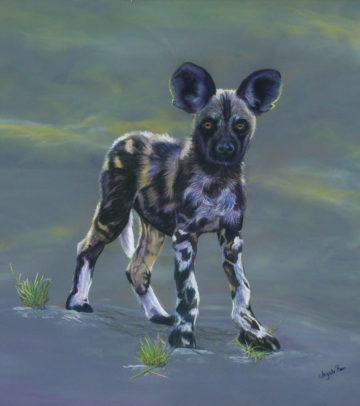
African Wild Dog Pup
Pastel on Pastelmat paper (Sold)
67 cm W x 61 cm H
The African Wild Dog (Lycaon pictus), also known as the Painted Dog, is a very clever carnivore with amazingly complex social hierarchies and extraordinary communication habits. They exhibit elaborate greeting rituals, care for injured pack mates, and have their own sneeze-based form of democracy. They are named for their mottled fur which is like paint splashed on a canvas, and each animal displays its own entirely unique pattern. Sadly, they are the second most endangered carnivore in all of Africa, with fewer than 1,400 mature adults in the wild. Human encroachment and diseases from domestic dogs are their greatest threats.
This little pup in Kenya, was nervously waiting for its mother to return from the hunt.Read moreAfrican Wild Dog Pup
Pastel on Pastelmat paper (Sold)
67 cm W x 61 cm H
The African Wild Dog (Lycaon pictus), also known as the Painted Dog, is a very clever carnivore with amazingly complex social hierarchies and extraordinary communication habits. They exhibit elaborate greeting rituals, care for injured pack mates, and have their own sneeze-based form of democracy. They are named for their mottled fur which is like paint splashed on a canvas, and each animal displays its own entirely unique pattern. Sadly, they are the second most endangered carnivore in all of Africa, with fewer than 1,400 mature adults in the wild. Human encroachment and diseases from domestic dogs are their greatest threats.
This little pup in Kenya, was nervously waiting for its mother to return from the hunt.Quick View -

An Uprising
Acrylic on canvas (Sold)
122 cm W x 122 cm H
This painting was one of 8 large canvases that formed the basis of my “Avian Criminals and Other Fine Feathered Friends” exhibition held in 2017 in the Northern Rivers Community Gallery. Each large canvas had a strong background colour and the birds painted thereon were given names that hinted at some kind of rebellion or misdeed. The Crested Pigeons (Ocyphaps lophotes) in this painting were chosen because of the whirring sound they make when they rise in fright from the ground. The source of the noise can be attributed to the way the air rushes over a modified primary feather found on the wings. This is most likely to draw the attention of predators to birds on the wing, and away from any birds remaining on the ground, and as an alarm call to other pigeons.Read moreAn Uprising
Acrylic on canvas (Sold)
122 cm W x 122 cm H
This painting was one of 8 large canvases that formed the basis of my “Avian Criminals and Other Fine Feathered Friends” exhibition held in 2017 in the Northern Rivers Community Gallery. Each large canvas had a strong background colour and the birds painted thereon were given names that hinted at some kind of rebellion or misdeed. The Crested Pigeons (Ocyphaps lophotes) in this painting were chosen because of the whirring sound they make when they rise in fright from the ground. The source of the noise can be attributed to the way the air rushes over a modified primary feather found on the wings. This is most likely to draw the attention of predators to birds on the wing, and away from any birds remaining on the ground, and as an alarm call to other pigeons.Quick View -

Andrew
Pastel on Pastelmat paper (Sold)
67 cm W x 88 cm H
Andrew is a big Red Kangaroo, (Macropus rufus) one of the many offspring of the famous alpha-male Red Kangaroo “Roger”, raised in the Kangaroo Sanctuary in Alice Springs. The Red Kangaroo is the largest of all kangaroos, which are terrestrial marsupials native to Australia, and they are found over most of the arid parts of the country, preferring flat open plains. Big Reds may weigh as much as 90kg and reach 1.8 meters in height when standing. When male kangaroos fight over potential mates, they appear to be boxing. They balance on their strong tails, grab their rival with their forearms and kick with their powerful hind legs. They attempt to push their opponent off balance. Kangaroos can also bite and wield sharp claws, which they may do in battle with an enemy like a dingo.Read moreAndrew
Pastel on Pastelmat paper (Sold)
67 cm W x 88 cm H
Andrew is a big Red Kangaroo, (Macropus rufus) one of the many offspring of the famous alpha-male Red Kangaroo “Roger”, raised in the Kangaroo Sanctuary in Alice Springs. The Red Kangaroo is the largest of all kangaroos, which are terrestrial marsupials native to Australia, and they are found over most of the arid parts of the country, preferring flat open plains. Big Reds may weigh as much as 90kg and reach 1.8 meters in height when standing. When male kangaroos fight over potential mates, they appear to be boxing. They balance on their strong tails, grab their rival with their forearms and kick with their powerful hind legs. They attempt to push their opponent off balance. Kangaroos can also bite and wield sharp claws, which they may do in battle with an enemy like a dingo.Quick View -
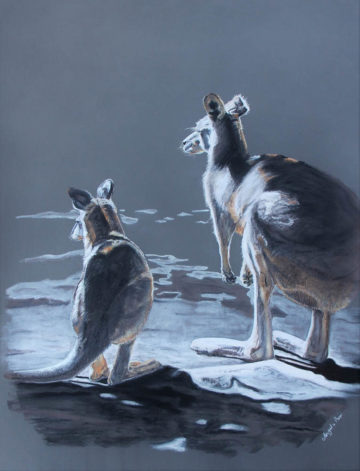
Morning Light
Pastel on Canson paper ($POA)
71 cm W x 91 cm H
The Eastern Grey Kangaroo, (Macropus giganteus), is one of 73 species of macropods. (The Greek words makros meaning large and poús or pod meaning foot) The key distinguishing features of all macropods are their triangular body shapes, large hind legs and feet, and disproportionately small front limbs. All have forward-facing pouches, and most use hopping as their primary mode of locomotion. The Eastern Grey is found in the eastern third of Australia, with a population of several million. They live in groups called Mobs and are highly sociable. Joeys usually stay in the pouch for 11 months and then continue to feed from their mother for an additional 9 months. This doe and joey were basking in the morning sunlight at Currumbin Wildlife Sanctuary.Read moreMorning Light
Pastel on Canson paper ($POA)
71 cm W x 91 cm H
The Eastern Grey Kangaroo, (Macropus giganteus), is one of 73 species of macropods. (The Greek words makros meaning large and poús or pod meaning foot) The key distinguishing features of all macropods are their triangular body shapes, large hind legs and feet, and disproportionately small front limbs. All have forward-facing pouches, and most use hopping as their primary mode of locomotion. The Eastern Grey is found in the eastern third of Australia, with a population of several million. They live in groups called Mobs and are highly sociable. Joeys usually stay in the pouch for 11 months and then continue to feed from their mother for an additional 9 months. This doe and joey were basking in the morning sunlight at Currumbin Wildlife Sanctuary.Quick View -

I am Elephant
Graphite on Arches paper ($POA)
42 cm W x 63 cm H
The African Bush Elephant (Loxodonta africana) is considered endangered, threatened by habitat loss and fragmentation, and poaching for the illegal ivory trade. African elephants have grey folded skin up to 30 mm thick that is covered with sparse, bristled dark brown to black hair. The trunk is a prehensile elongation of its upper lip and nose, manipulated by about 40,000–60,000 muscles and so strong that elephants can use it for lifting about 3% of their own body weight. They use it for smelling, touching, feeding, drinking, dusting, producing sounds, loading, defending and attacking. This artwork focuses on the skin, trunk and tusk of a large bull and attempts to convey the immense size and strength of these magnificent creatures.Read moreI am Elephant
Graphite on Arches paper ($POA)
42 cm W x 63 cm H
The African Bush Elephant (Loxodonta africana) is considered endangered, threatened by habitat loss and fragmentation, and poaching for the illegal ivory trade. African elephants have grey folded skin up to 30 mm thick that is covered with sparse, bristled dark brown to black hair. The trunk is a prehensile elongation of its upper lip and nose, manipulated by about 40,000–60,000 muscles and so strong that elephants can use it for lifting about 3% of their own body weight. They use it for smelling, touching, feeding, drinking, dusting, producing sounds, loading, defending and attacking. This artwork focuses on the skin, trunk and tusk of a large bull and attempts to convey the immense size and strength of these magnificent creatures.Quick View -
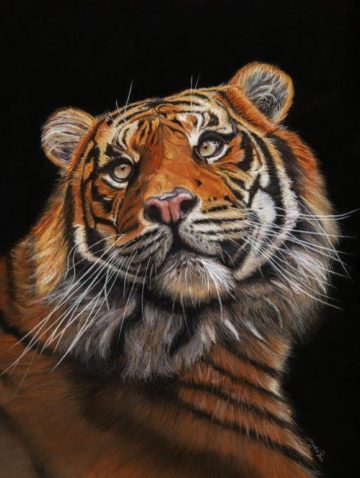
Just a Big Pussycat
Pastel on Colour Fix Art Spectrum paper ($POA)
44 cm W x 58 cm H
The Indian Tiger (Panthera tigris) is surely the most stunning of the big cats, with its distinctive dark vertical stripes on orange fur with a white underside. It is an apex predator, primarily preying on ungulates such as deer and wild boar. It is territorial and generally solitary. It is listed as endangered on the IUCN Red List. As of 2024, the global wild tiger population was estimated to number of 5,574 mature individuals, with most living in small, isolated pockets. Major reasons for population decline are habitat destruction, habitat fragmentation, human-wildlife conflict and poaching.
source World Animal FoundationRead moreJust a Big Pussycat
Pastel on Colour Fix Art Spectrum paper ($POA)
44 cm W x 58 cm H
The Indian Tiger (Panthera tigris) is surely the most stunning of the big cats, with its distinctive dark vertical stripes on orange fur with a white underside. It is an apex predator, primarily preying on ungulates such as deer and wild boar. It is territorial and generally solitary. It is listed as endangered on the IUCN Red List. As of 2024, the global wild tiger population was estimated to number of 5,574 mature individuals, with most living in small, isolated pockets. Major reasons for population decline are habitat destruction, habitat fragmentation, human-wildlife conflict and poaching.
source World Animal FoundationQuick View -
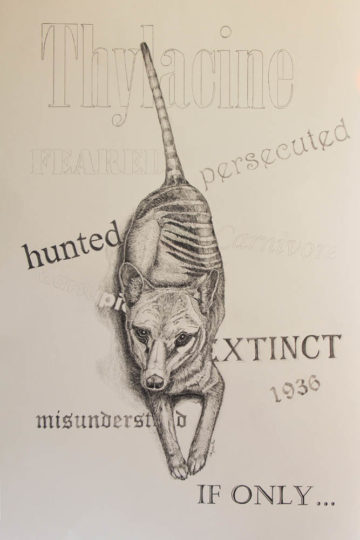
If Only… (Thylacine)
Graphite on Cotton Rag paper (Sold)
53 cm W x 75 cm H
The Tasmanian Tiger (Thylacinus cynocephalus) meaning dog-headed pouched-dog, was a large carnivorous marsupial now believed to be extinct. Once roaming all of mainland Australia it is estimated there were around 5000 thylacines in Tasmania at the time of European settlement. Shamefully, whilst its decline and extinction was hastened by habitat destruction and introduced diseases from dogs, largely its demise was due to human persecution and hunting as an alleged pest. Sadly, the last known thylacine died from exposure at a Zoo in Hobart on 7 September 1936 only two months after the species was granted protected status.
Not having a live specimen to draw from, I taped “stripes” to my cattle dog and used her as the basis for this artwork, refining the details as I worked.Read moreIf Only… (Thylacine)
Graphite on Cotton Rag paper (Sold)
53 cm W x 75 cm H
The Tasmanian Tiger (Thylacinus cynocephalus) meaning dog-headed pouched-dog, was a large carnivorous marsupial now believed to be extinct. Once roaming all of mainland Australia it is estimated there were around 5000 thylacines in Tasmania at the time of European settlement. Shamefully, whilst its decline and extinction was hastened by habitat destruction and introduced diseases from dogs, largely its demise was due to human persecution and hunting as an alleged pest. Sadly, the last known thylacine died from exposure at a Zoo in Hobart on 7 September 1936 only two months after the species was granted protected status.
Not having a live specimen to draw from, I taped “stripes” to my cattle dog and used her as the basis for this artwork, refining the details as I worked.Quick View -
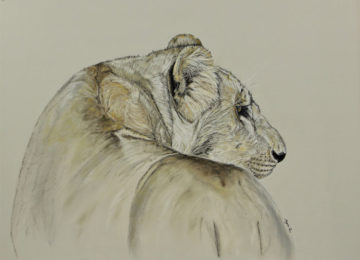
The Huntress
Pastel on Pastelmat Board ($POA)
(size to come)
Lions (Panthera leo) are unique among cats in that they live in a pride, often consisting of about 15 individuals. Lionesses are the chief hunters. They prey on animals of all sizes, including hippopotamuses, but prefer wildebeests, antelopes, and zebras. Lionesses are much faster than their male counterparts because of their sleeker and lighter bodies. A Lion runs at 35 mph however a Lioness can reach up to a speed of 45 mph.
This beautiful female in Tanzania was testing the breeze for possible prey in the vicinity.Read moreThe Huntress
Pastel on Pastelmat Board ($POA)
(size to come)
Lions (Panthera leo) are unique among cats in that they live in a pride, often consisting of about 15 individuals. Lionesses are the chief hunters. They prey on animals of all sizes, including hippopotamuses, but prefer wildebeests, antelopes, and zebras. Lionesses are much faster than their male counterparts because of their sleeker and lighter bodies. A Lion runs at 35 mph however a Lioness can reach up to a speed of 45 mph.
This beautiful female in Tanzania was testing the breeze for possible prey in the vicinity.Quick View -
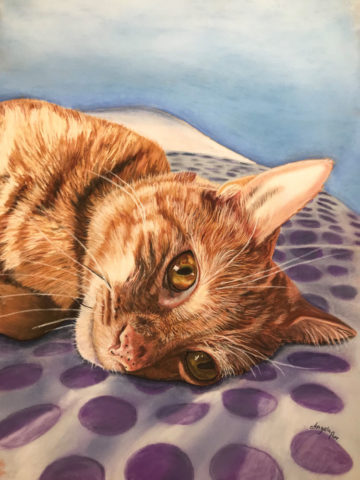
Leo
Pastel on Pastelmat Board (Sold)
25 cm W x 35 cm H
Leo was a much-loved pet of my sister-in-law, and I drew him as a gift for her birthday. In an ironic twist of fate, Leo was killed days after the portrait arrived. She was forever grateful to have this reminder of him.Read moreLeo
Pastel on Pastelmat Board (Sold)
25 cm W x 35 cm H
Leo was a much-loved pet of my sister-in-law, and I drew him as a gift for her birthday. In an ironic twist of fate, Leo was killed days after the portrait arrived. She was forever grateful to have this reminder of him.Quick View -
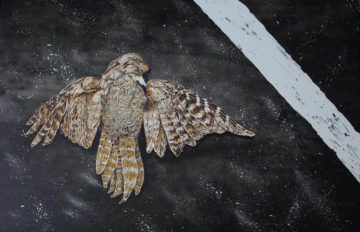
The Thin White Line
Watercolour on board (Sold)
90 cm W x 71 cm H
I used to own a studio out of town and driving there one day I found a freshly killed beautiful Tawny Frogmouth (Podargus strigoides) that appeared to have been just hit by a vehicle that passed through a few minutes before me. There wasn’t a mark on the body, and as it was just too lovely to discard, I decided to take it to my studio and immortalise it in an artwork. The background is both the road with it’s white dividing line and heaven to which the bird is ascending. Hence the title which also implies the fragile line between life and death.Read moreThe Thin White Line
Watercolour on board (Sold)
90 cm W x 71 cm H
I used to own a studio out of town and driving there one day I found a freshly killed beautiful Tawny Frogmouth (Podargus strigoides) that appeared to have been just hit by a vehicle that passed through a few minutes before me. There wasn’t a mark on the body, and as it was just too lovely to discard, I decided to take it to my studio and immortalise it in an artwork. The background is both the road with it’s white dividing line and heaven to which the bird is ascending. Hence the title which also implies the fragile line between life and death.Quick View -
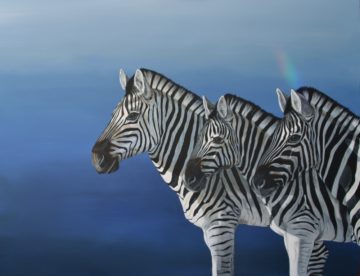
Watching the Lions
Acrylic on Canvas (Sold)
102 cm W x 76 cm H
Plains Zebras (Equus quagga) are the most common of the three zebra species and found in much of southern and eastern Africa south of the Sahara. Zebras have black skin with white stripes which help keep them cool. The stripes are thought to disperse more than 70% of incoming heat, preventing them from overheating in the sweltering African sun. Air moves at different speeds over light-absorbing black stripes and light-reflecting white stripes, so the animal creates its own cooling air currents. These three were standing around a waterhole in Namibia watching a young lion practise her hunting techniques, highly alert for a quick getaway if required.Read moreWatching the Lions
Acrylic on Canvas (Sold)
102 cm W x 76 cm H
Plains Zebras (Equus quagga) are the most common of the three zebra species and found in much of southern and eastern Africa south of the Sahara. Zebras have black skin with white stripes which help keep them cool. The stripes are thought to disperse more than 70% of incoming heat, preventing them from overheating in the sweltering African sun. Air moves at different speeds over light-absorbing black stripes and light-reflecting white stripes, so the animal creates its own cooling air currents. These three were standing around a waterhole in Namibia watching a young lion practise her hunting techniques, highly alert for a quick getaway if required.Quick View -
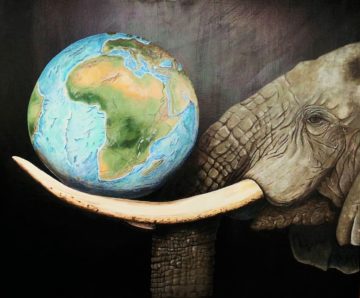
Only an Elephant Needs Ivory
Acrylic on Canvas (Sold)
102 cm W x 76 cm H
Elephant tusks are primarily used to dig for roots and strip the bark from trees for food, for fighting each other during mating season, and for defending themselves against predators. The tusks weigh from 23 to 45 kg and can be from 1.5 to 2.4 m long. Tusks have no intrinsic value, but ivory has been a status symbol for millennia in Africa because it comes from elephants, a highly respected animal, and because it is easy to carve into works of art. An African poacher can get $80 for a kilogram of ivory which is a lot of money in most African countries. But the big profit is made in Asia. Thai Customs recently evaluated smuggled ivory as being worth $1,800 per kilogram wholesale. And of course it is almost impossible to remove tusks from wild elephants without having to kill them first. My artwork draws attention to this shameful trade.Read moreOnly an Elephant Needs Ivory
Acrylic on Canvas (Sold)
102 cm W x 76 cm H
Elephant tusks are primarily used to dig for roots and strip the bark from trees for food, for fighting each other during mating season, and for defending themselves against predators. The tusks weigh from 23 to 45 kg and can be from 1.5 to 2.4 m long. Tusks have no intrinsic value, but ivory has been a status symbol for millennia in Africa because it comes from elephants, a highly respected animal, and because it is easy to carve into works of art. An African poacher can get $80 for a kilogram of ivory which is a lot of money in most African countries. But the big profit is made in Asia. Thai Customs recently evaluated smuggled ivory as being worth $1,800 per kilogram wholesale. And of course it is almost impossible to remove tusks from wild elephants without having to kill them first. My artwork draws attention to this shameful trade.Quick View -
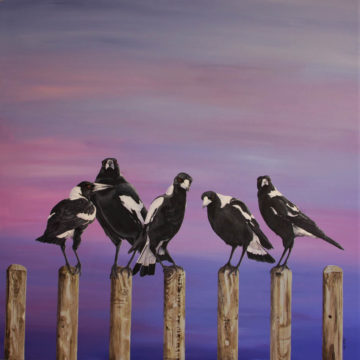
The Mob
Acrylic on canvas (Sold)
122 cm W x 122 cm H
Another of my “Avian Criminal” pieces, this study of “tough guy” Australian magpies (Cracticus tibicen) has the large bird Marlon (as in Brando fame) surrounded by the rest of his “mob”. All the birds are exhibiting that haughty, intense stare magpies are renowned for. Apart from its widespread distribution — there are few places in Australia where magpies do not occur — the species’ familiarity is probably due equally to its pleasant carolling song, which is such an essential part of the Australian soundscape, and for its tendency to swoop at people during its springtime nesting season. The poles the magpies are perched on were modelled upon poles that had been newly erected at a nearby beach and were instantly recognised by the locals.Read moreThe Mob
Acrylic on canvas (Sold)
122 cm W x 122 cm H
Another of my “Avian Criminal” pieces, this study of “tough guy” Australian magpies (Cracticus tibicen) has the large bird Marlon (as in Brando fame) surrounded by the rest of his “mob”. All the birds are exhibiting that haughty, intense stare magpies are renowned for. Apart from its widespread distribution — there are few places in Australia where magpies do not occur — the species’ familiarity is probably due equally to its pleasant carolling song, which is such an essential part of the Australian soundscape, and for its tendency to swoop at people during its springtime nesting season. The poles the magpies are perched on were modelled upon poles that had been newly erected at a nearby beach and were instantly recognised by the locals.Quick View -
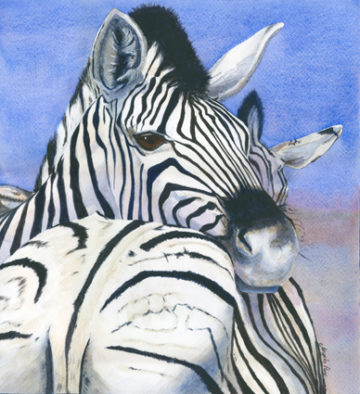
The Rear Guard
Watercolour on Arches paper ($POA)
30 cm W x 33 cm H
Being the favourite prey of lions, zebras must always be alert, and often stand head to tail to keep an eye on the terrain all around them. Naturally when they stand this way, they can also give each other a good scratch on the rump, and with their tails constantly swishing, help chase flies away from each other’s faces.Read moreThe Rear Guard
Watercolour on Arches paper ($POA)
30 cm W x 33 cm H
Being the favourite prey of lions, zebras must always be alert, and often stand head to tail to keep an eye on the terrain all around them. Naturally when they stand this way, they can also give each other a good scratch on the rump, and with their tails constantly swishing, help chase flies away from each other’s faces.Quick View -
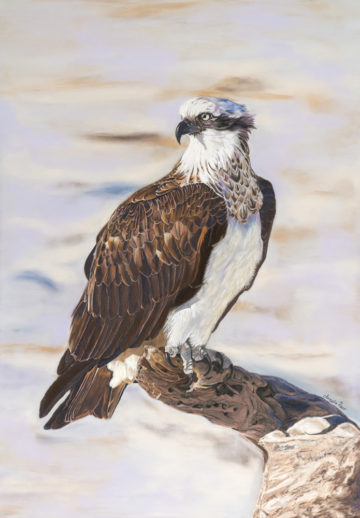
The Observer
Pastel on Pastelmat (Sold)
46 cm W x 66 cm H
The Eastern Osprey (Pandion cristatus) is a familiar sight on the Ballina/Byron coastline, so I was surprised to learn its status is “vulnerable” in NSW. Osprey often return to the same nest, so habitat destruction and disturbance often disrupts nesting. Discarded fishing tackle, contaminated fish, polluted waterways and electrocution from nesting on powerline poles also pose serious threats. Fortunately, our council has erected several Osprey Breeding Platforms and I am accustomed to see them circling the skies, hear them whistle to each other, and in breeding season, see little fluff balls peek over the nest’s edge. They are a majestic bird.Read moreThe Observer
Pastel on Pastelmat (Sold)
46 cm W x 66 cm H
The Eastern Osprey (Pandion cristatus) is a familiar sight on the Ballina/Byron coastline, so I was surprised to learn its status is “vulnerable” in NSW. Osprey often return to the same nest, so habitat destruction and disturbance often disrupts nesting. Discarded fishing tackle, contaminated fish, polluted waterways and electrocution from nesting on powerline poles also pose serious threats. Fortunately, our council has erected several Osprey Breeding Platforms and I am accustomed to see them circling the skies, hear them whistle to each other, and in breeding season, see little fluff balls peek over the nest’s edge. They are a majestic bird.Quick View -
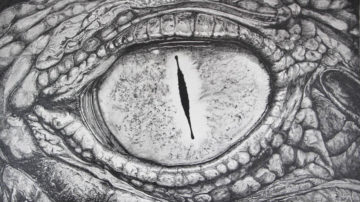
Watching and Waiting 1
Graphite on Arches paper (Sold)
45 cm W x 33 cm H
Earth’s largest living crocodilian—and, some say, the animal most likely to eat a human—is the saltwater or estuarine crocodile, (Crocodylus porosus). The typical male Saltwater Crocodile has an overall length of 4.25-7 m, with females at lengths of 2.30-3.35 m. An average male Saltwater Crocodile weighs between 400-1000 kg and has a typical lifespan of 70-100 years in the wild.
I have equal parts fascination and fear of these ancient reptiles but managed to convince myself to swim for 15 minutes in the famous “Cage of Death”, at Crocosaurus Cove in Darwin and eyeball a 5-metre monster through the acrylic-strengthened “glass” cage.Read moreWatching and Waiting 1
Graphite on Arches paper (Sold)
45 cm W x 33 cm H
Earth’s largest living crocodilian—and, some say, the animal most likely to eat a human—is the saltwater or estuarine crocodile, (Crocodylus porosus). The typical male Saltwater Crocodile has an overall length of 4.25-7 m, with females at lengths of 2.30-3.35 m. An average male Saltwater Crocodile weighs between 400-1000 kg and has a typical lifespan of 70-100 years in the wild.
I have equal parts fascination and fear of these ancient reptiles but managed to convince myself to swim for 15 minutes in the famous “Cage of Death”, at Crocosaurus Cove in Darwin and eyeball a 5-metre monster through the acrylic-strengthened “glass” cage.Quick View -
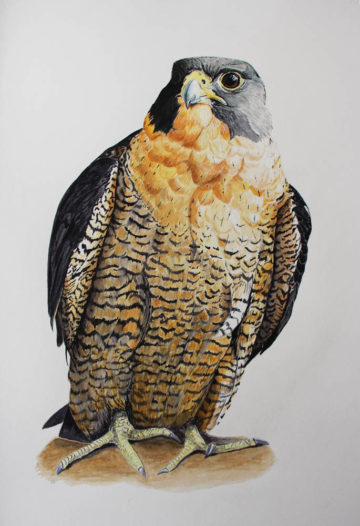
Peregrine Falcon
Watercolour on Arches paper ($POA)
49 cm W x 68 cm H
The peregrine falcon (Falco peregrinus) is the world’s most widespread raptor found nearly everywhere on Earth, except extreme polar regions, very high mountains, and most tropical rainforests. The peregrine is renowned for its speed, reaching over 320 km/h during its characteristic hunting stoop (high-speed dive), making it the fastest bird in the world, and the fastest member of the animal kingdom. Although its diet consists almost exclusively of medium-sized birds, the peregrine will sometimes hunt small mammals, small reptiles, or even insects. Reaching sexual maturity at one year, it mates for life and nests in a scrape, normally on cliff edges or, in recent times, on tall human-made structures. Since 1991, a pair of Peregrine Falcons has been observed in a nest on the rooftop of 367 Collins Street. As home to the only known peregrine falcon nesting site within Melbourne’s CBD, the building plays a surprisingly important role to the ongoing breeding success of these rare and fiercely territorial birds. The magnificent specimen in my artwork was recovering from injury in a raptor sanctuary before being released back into the wild.Read morePeregrine Falcon
Watercolour on Arches paper ($POA)
49 cm W x 68 cm H
The peregrine falcon (Falco peregrinus) is the world’s most widespread raptor found nearly everywhere on Earth, except extreme polar regions, very high mountains, and most tropical rainforests. The peregrine is renowned for its speed, reaching over 320 km/h during its characteristic hunting stoop (high-speed dive), making it the fastest bird in the world, and the fastest member of the animal kingdom. Although its diet consists almost exclusively of medium-sized birds, the peregrine will sometimes hunt small mammals, small reptiles, or even insects. Reaching sexual maturity at one year, it mates for life and nests in a scrape, normally on cliff edges or, in recent times, on tall human-made structures. Since 1991, a pair of Peregrine Falcons has been observed in a nest on the rooftop of 367 Collins Street. As home to the only known peregrine falcon nesting site within Melbourne’s CBD, the building plays a surprisingly important role to the ongoing breeding success of these rare and fiercely territorial birds. The magnificent specimen in my artwork was recovering from injury in a raptor sanctuary before being released back into the wild.Quick View -
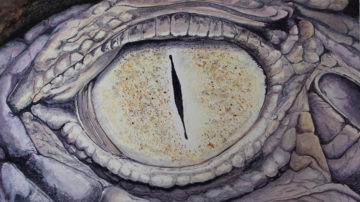
Watching and Waiting 2
Watercolour on Arches paper (Sold)
45 cm W x 33 cm H
Saltwater crocodiles were hunted close to extinction before they were declared a protected species in the 1970s. It’s estimated as few as 3000 were left in the Northern Territory when hunting was bad – but in the decades since, numbers have boomed. Exact populations are unknown, but it’s estimated the NT waterways are now home to about 100,000 “salties”, and Queensland 30,000. As the increase in numbers eases off, the size of the creatures increases, with males capable of reaching 6 metres.
This artwork is a repeat of the previous one but completed in watercolours. It’s interesting how this gives a different feel to the same subject.Read moreWatching and Waiting 2
Watercolour on Arches paper (Sold)
45 cm W x 33 cm H
Saltwater crocodiles were hunted close to extinction before they were declared a protected species in the 1970s. It’s estimated as few as 3000 were left in the Northern Territory when hunting was bad – but in the decades since, numbers have boomed. Exact populations are unknown, but it’s estimated the NT waterways are now home to about 100,000 “salties”, and Queensland 30,000. As the increase in numbers eases off, the size of the creatures increases, with males capable of reaching 6 metres.
This artwork is a repeat of the previous one but completed in watercolours. It’s interesting how this gives a different feel to the same subject.Quick View -
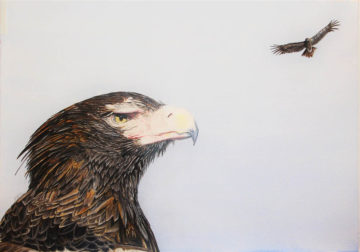
Aquila Audax
Watercolour and coloured pencil on Arches paper ($POA)
76 cm W x 60 cm H
The wedge-tailed eagle (Aquila audax) is the largest bird of prey in Australia, with an impressive wing span of up to 2.84 m and a body length up to 1.06 m. Females weigh between 3-6kg , whilst males are slightly lighter at 2-4kg. Wedge-tailed eagles are highly aerial, soaring for hours on end without wingbeat and seemingly without effort, regularly reaching 1,800 m. Most prey is captured on the ground in gliding attacks. Choice of prey include the introduced rabbit and brown hare, (their diet of choice) foxes and feral cats, native wallabies, small kangaroos, possums, wombats, koalas, and bandicoots. In some areas, birds and reptiles may also be taken. “Wedgies” have also been known to team up to hunt large red kangaroos, to cause goats to fall off steep hillsides and injure themselves, or to drive flocks of sheep or kangaroos to isolate a weaker animal.Read moreAquila Audax
Watercolour and coloured pencil on Arches paper ($POA)
76 cm W x 60 cm H
The wedge-tailed eagle (Aquila audax) is the largest bird of prey in Australia, with an impressive wing span of up to 2.84 m and a body length up to 1.06 m. Females weigh between 3-6kg , whilst males are slightly lighter at 2-4kg. Wedge-tailed eagles are highly aerial, soaring for hours on end without wingbeat and seemingly without effort, regularly reaching 1,800 m. Most prey is captured on the ground in gliding attacks. Choice of prey include the introduced rabbit and brown hare, (their diet of choice) foxes and feral cats, native wallabies, small kangaroos, possums, wombats, koalas, and bandicoots. In some areas, birds and reptiles may also be taken. “Wedgies” have also been known to team up to hunt large red kangaroos, to cause goats to fall off steep hillsides and injure themselves, or to drive flocks of sheep or kangaroos to isolate a weaker animal.Quick View -
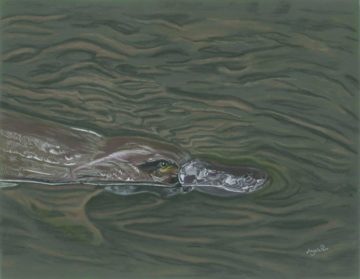
Platypus Oma
Pastel on Mi Tientes Tex ($POA)
49 cm W x 42 cm H
During February 2019 tropical cyclone Oma caused gale force winds, abnormally high tides and large surf about the southeast Queensland coast, northern New South Wales coast and Lord Howe Island. During this period a platypus (Ornithorhynchus anatinus) found its way into our small creek and pond, displaying little fear of us as it hunted for freshwater yabbies. Naturally it became known as Platypus Oma and had to be immortalised in art. The IUCN lists the platypus on its Red List as “Near Threatened” as assessed in 2016, when it was estimated that numbers had reduced by about 30 percent on average since European settlement. Since Platypus Oma we have spotted another two platypi in our creek at different times and are always thrilled to do so.Read morePlatypus Oma
Pastel on Mi Tientes Tex ($POA)
49 cm W x 42 cm H
During February 2019 tropical cyclone Oma caused gale force winds, abnormally high tides and large surf about the southeast Queensland coast, northern New South Wales coast and Lord Howe Island. During this period a platypus (Ornithorhynchus anatinus) found its way into our small creek and pond, displaying little fear of us as it hunted for freshwater yabbies. Naturally it became known as Platypus Oma and had to be immortalised in art. The IUCN lists the platypus on its Red List as “Near Threatened” as assessed in 2016, when it was estimated that numbers had reduced by about 30 percent on average since European settlement. Since Platypus Oma we have spotted another two platypi in our creek at different times and are always thrilled to do so.Quick View -
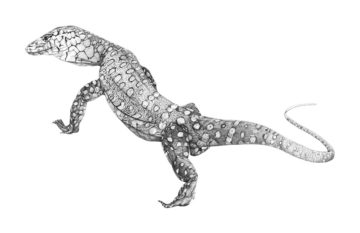
Perentie
Ink on Arches paper (Sold)
90 cm W x 65 cm H
The perentie (Varanus giganteus) is the largest monitor lizard or goanna native to Australia. It is the fourth-largest living lizard on earth, after the Komodo dragon, Asian water monitor, and the crocodile monitor. Found west of the Great Dividing Range in the arid areas of Australia, it is rarely seen, because of its shyness and the remoteness of much of its range from human habitation. They can grow up to 2.5 m long, (although the typical length is around 1.7 to 2.0 m) and weigh up to 15 kg. This healthy specimen scarpered over the road in front of us near Arltunga in the Northern Territory and I managed a quick photo before it disappeared into the scrub.Read morePerentie
Ink on Arches paper (Sold)
90 cm W x 65 cm H
The perentie (Varanus giganteus) is the largest monitor lizard or goanna native to Australia. It is the fourth-largest living lizard on earth, after the Komodo dragon, Asian water monitor, and the crocodile monitor. Found west of the Great Dividing Range in the arid areas of Australia, it is rarely seen, because of its shyness and the remoteness of much of its range from human habitation. They can grow up to 2.5 m long, (although the typical length is around 1.7 to 2.0 m) and weigh up to 15 kg. This healthy specimen scarpered over the road in front of us near Arltunga in the Northern Territory and I managed a quick photo before it disappeared into the scrub.Quick View -
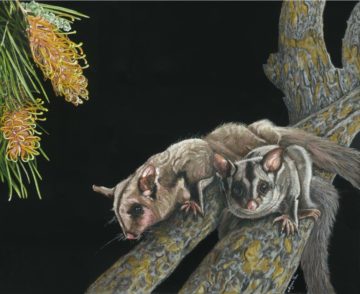
Scamper and Scurry
Pastel on Mi Tientes Tex (Sold)
53 cm W x 43 cm H
The models for this artwork are Samson and Sebastian, four-year-old brothers and the resident Sugar gliders of Byron Bay Wildlife Sanctuary (formerly Macadamia Castle). The sugar glider (Petaurus breviceps) is a small, omnivorous, arboreal, and nocturnal gliding possum belonging to the marsupial infraclass. The common name refers to its predilection for sugary foods such as sap and nectar (hence the inclusion of the grevillea in the artwork) and its ability to glide through the air, much like a flying squirrel. Its pair of gliding membranes, known as patagia, extend from its forelegs to its hindlegs enabling it to glide 50 metres or more. Gliding serves as an efficient means of reaching food and evading predators.Read moreScamper and Scurry
Pastel on Mi Tientes Tex (Sold)
53 cm W x 43 cm H
The models for this artwork are Samson and Sebastian, four-year-old brothers and the resident Sugar gliders of Byron Bay Wildlife Sanctuary (formerly Macadamia Castle). The sugar glider (Petaurus breviceps) is a small, omnivorous, arboreal, and nocturnal gliding possum belonging to the marsupial infraclass. The common name refers to its predilection for sugary foods such as sap and nectar (hence the inclusion of the grevillea in the artwork) and its ability to glide through the air, much like a flying squirrel. Its pair of gliding membranes, known as patagia, extend from its forelegs to its hindlegs enabling it to glide 50 metres or more. Gliding serves as an efficient means of reaching food and evading predators.Quick View -
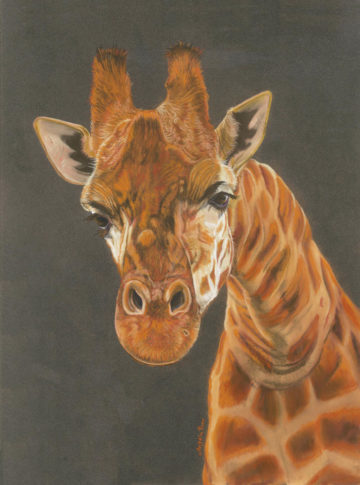
Well Hello There
Pastel on Pastelmat paper ($POA)
45 cm W x 55 cm H
On a lovely morning at Taronga Western Plains Zoo, Dubbo, NSW, we were fortunate to have a private tour of the Savannah where many African animals roam freely. A curious male giraffe poked his long neck (and head) into our jeep searching for treats. Both male and female giraffes have horns, but the tops of the horns on a male are almost always bald, whilst the female’s horns will be completely covered with hair. As females don’t fight, they never lose the hair on their horns.
The Giraffe is the tallest of all animals, with males sometimes growing up to 5.5 metres in height and weighing over 1000 kg! The northern giraffe (Giraffa camelopardalis), also known as the three-horned giraffe, is the species of giraffe native to North Africa. Once abundant throughout Africa since the 19th century, it is now isolated in South Sudan, Kenya, Chad and Niger. All giraffes are considered ‘Vulnerable to Extinction’ by the IUCN. There are currently only 5,195 northern giraffes in the wild.Read moreWell Hello There
Pastel on Pastelmat paper ($POA)
45 cm W x 55 cm H
On a lovely morning at Taronga Western Plains Zoo, Dubbo, NSW, we were fortunate to have a private tour of the Savannah where many African animals roam freely. A curious male giraffe poked his long neck (and head) into our jeep searching for treats. Both male and female giraffes have horns, but the tops of the horns on a male are almost always bald, whilst the female’s horns will be completely covered with hair. As females don’t fight, they never lose the hair on their horns.
The Giraffe is the tallest of all animals, with males sometimes growing up to 5.5 metres in height and weighing over 1000 kg! The northern giraffe (Giraffa camelopardalis), also known as the three-horned giraffe, is the species of giraffe native to North Africa. Once abundant throughout Africa since the 19th century, it is now isolated in South Sudan, Kenya, Chad and Niger. All giraffes are considered ‘Vulnerable to Extinction’ by the IUCN. There are currently only 5,195 northern giraffes in the wild.Quick View -
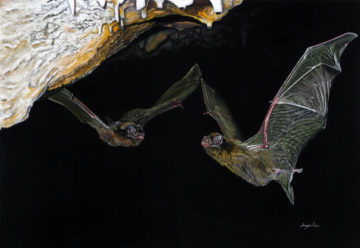
Common Bentwing Bats on the Wing
Pastel on Canson paper ($POA)
63 cm W x 48 cm H
A brilliant fellow artist Andy Reimanis invited me to participate in a joint exhibition of local micro things, in the gallery at Murwillumbah on the banks of the Tweed River. I would represent microbats and he would represent microflora. What followed couldn’t have been scripted… Heavy rainfall in the wake of ex Cyclone Debbie in March 2017 caused major flooding in the states of Queensland and New South Wales. Mullumbimby recorded over 300 mm of rain in 24 hours and the Tweed River reached levels not seen for over 40 years. Authorities ordered over 20,000 people to evacuate their homes. The gallery was completely devastated. Our exhibition never materialised but the artwork had been completed thanks to the generous provision of reference material from Bruce Thomson of QNPWS and Terry Reardon from the South Australian Museum. This piece was one of those created during this time.Read moreCommon Bentwing Bats on the Wing
Pastel on Canson paper ($POA)
63 cm W x 48 cm H
A brilliant fellow artist Andy Reimanis invited me to participate in a joint exhibition of local micro things, in the gallery at Murwillumbah on the banks of the Tweed River. I would represent microbats and he would represent microflora. What followed couldn’t have been scripted… Heavy rainfall in the wake of ex Cyclone Debbie in March 2017 caused major flooding in the states of Queensland and New South Wales. Mullumbimby recorded over 300 mm of rain in 24 hours and the Tweed River reached levels not seen for over 40 years. Authorities ordered over 20,000 people to evacuate their homes. The gallery was completely devastated. Our exhibition never materialised but the artwork had been completed thanks to the generous provision of reference material from Bruce Thomson of QNPWS and Terry Reardon from the South Australian Museum. This piece was one of those created during this time.Quick View -
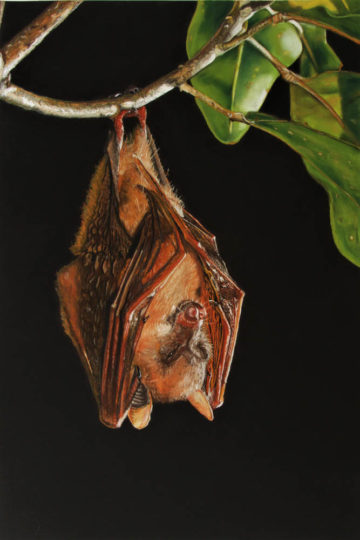
Eastern Blossom Bat
Pastel on Canson paper (SOLD)
46 cm W x 62 cm H
Another in my microbat series although technically Blossom Bats are a bit larger in size than true microbats. Also known as the Common Blossom Bat or the Southern Blossom Bat, the Eastern Blossom Bat (Syconycteris australis) is a small nectar feeding bat. Habitat includes rainforests, wet eucalypt forests and paperbark swamps throughout eastern and north-eastern Australia. It is fawn to reddish-brown in colour above with a paler belly. It has a long narrow (I think very cute) face, large eyes and a very long thin tongue, with a brush-like tip. Its diet is highly specialised, consisting of nectar and pollen from bottlebrush, paperbark, banksia and gum tree blossoms. It is an important pollinator of many rainforest plants.Read moreEastern Blossom Bat
Pastel on Canson paper (SOLD)
46 cm W x 62 cm H
Another in my microbat series although technically Blossom Bats are a bit larger in size than true microbats. Also known as the Common Blossom Bat or the Southern Blossom Bat, the Eastern Blossom Bat (Syconycteris australis) is a small nectar feeding bat. Habitat includes rainforests, wet eucalypt forests and paperbark swamps throughout eastern and north-eastern Australia. It is fawn to reddish-brown in colour above with a paler belly. It has a long narrow (I think very cute) face, large eyes and a very long thin tongue, with a brush-like tip. Its diet is highly specialised, consisting of nectar and pollen from bottlebrush, paperbark, banksia and gum tree blossoms. It is an important pollinator of many rainforest plants.Quick View -
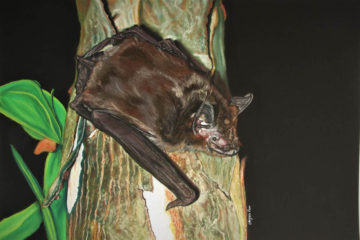
Eastern Falsistrelle
Pastel on Canson paper (Sold)
63 cm W x 48 cm H
Very little is known about Eastern False Pipistrelles or Falsistrelles (Falsistrellus tasmaniensis). They feed on insects, including moths, beetles and ants. Like all microbats they are a wonderfully natural method of pest control as they devour lawn grub moths, weevils, caterpillars, beetles, midges, flying termites, mosquitoes and other insects. Microbats can eat as much as 40% of their own body weight in a single night or several hundred insects per hour. Sadly they are under threat from intensive forestry activity in their habitat, cleared for agriculture and housing, as they roost in hollows in old trees in higher rainfall forests. They do however occasionally roost in disused buildings.Read moreEastern Falsistrelle
Pastel on Canson paper (Sold)
63 cm W x 48 cm H
Very little is known about Eastern False Pipistrelles or Falsistrelles (Falsistrellus tasmaniensis). They feed on insects, including moths, beetles and ants. Like all microbats they are a wonderfully natural method of pest control as they devour lawn grub moths, weevils, caterpillars, beetles, midges, flying termites, mosquitoes and other insects. Microbats can eat as much as 40% of their own body weight in a single night or several hundred insects per hour. Sadly they are under threat from intensive forestry activity in their habitat, cleared for agriculture and housing, as they roost in hollows in old trees in higher rainfall forests. They do however occasionally roost in disused buildings.Quick View

